Disseminating awareness among Indian Diabetic patients
VerifiedAdded on 2023/01/19
|25
|6022
|36
AI Summary
This research proposal aims to conduct an online education program to impart health literacy and self-management strategies to Indian patients suffering from Diabetes. It discusses the background, problem statement, research rationale, aim, objectives, and expected outcomes of the study.
Contribute Materials
Your contribution can guide someone’s learning journey. Share your
documents today.
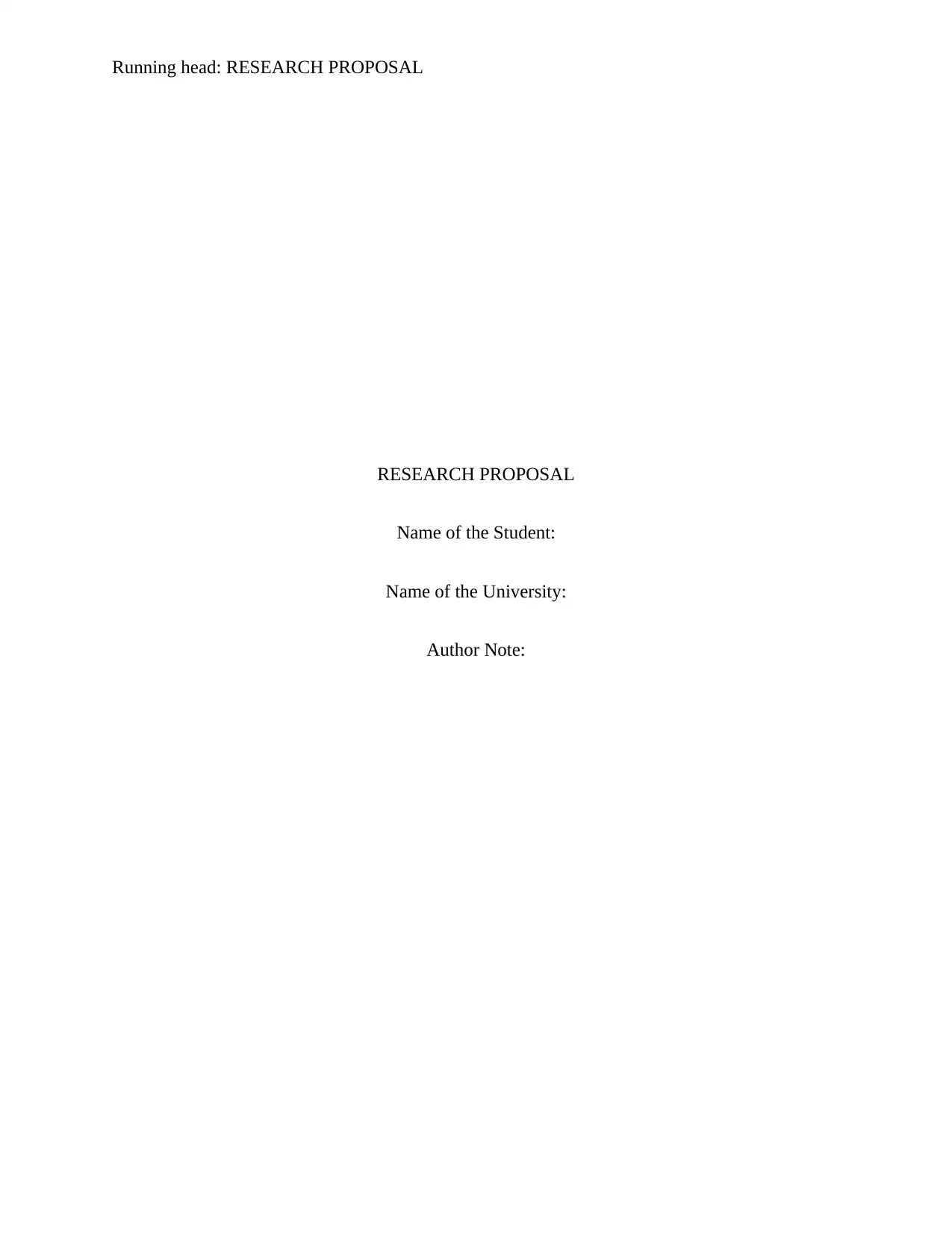
Running head: RESEARCH PROPOSAL
RESEARCH PROPOSAL
Name of the Student:
Name of the University:
Author Note:
RESEARCH PROPOSAL
Name of the Student:
Name of the University:
Author Note:
Secure Best Marks with AI Grader
Need help grading? Try our AI Grader for instant feedback on your assignments.
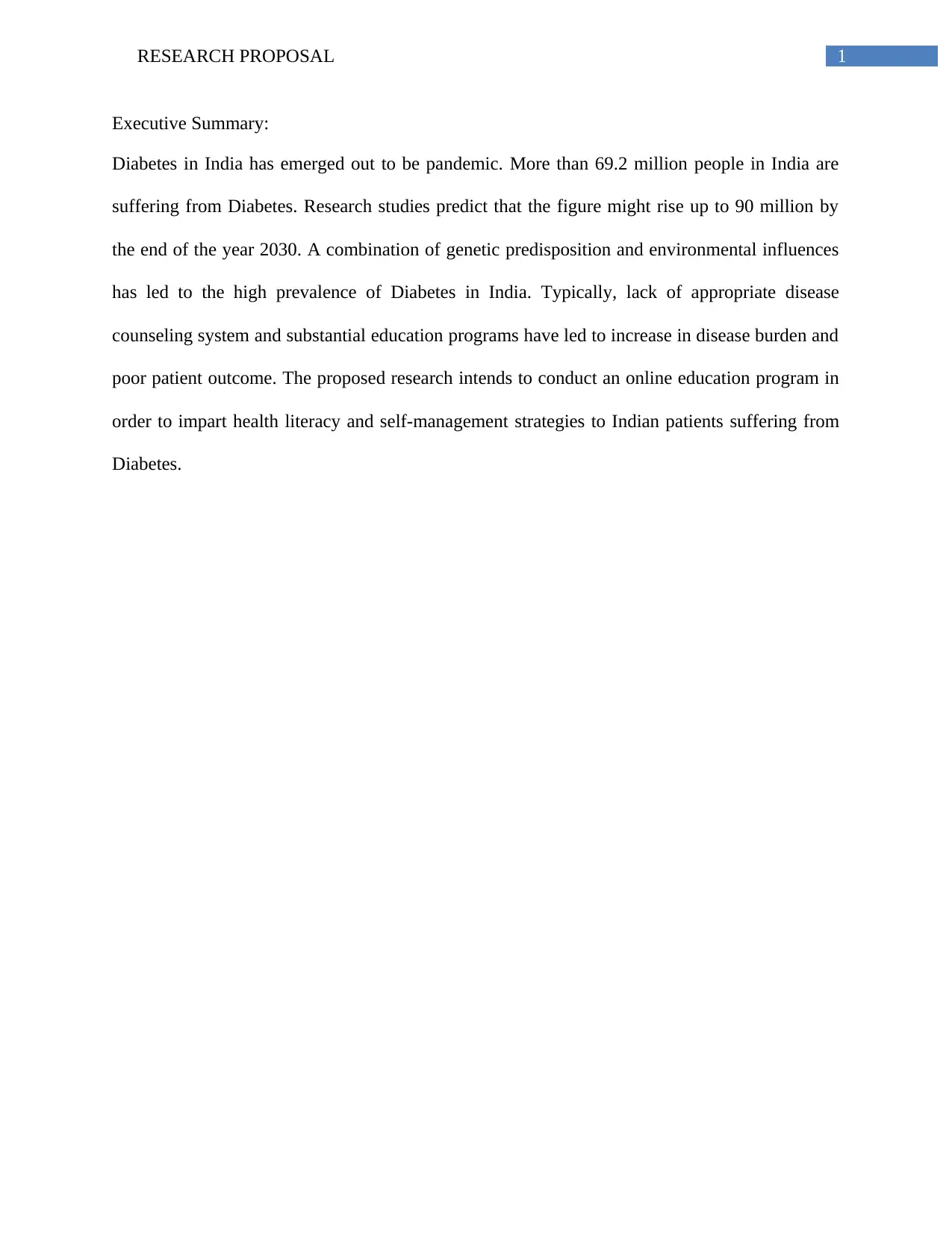
1RESEARCH PROPOSAL
Executive Summary:
Diabetes in India has emerged out to be pandemic. More than 69.2 million people in India are
suffering from Diabetes. Research studies predict that the figure might rise up to 90 million by
the end of the year 2030. A combination of genetic predisposition and environmental influences
has led to the high prevalence of Diabetes in India. Typically, lack of appropriate disease
counseling system and substantial education programs have led to increase in disease burden and
poor patient outcome. The proposed research intends to conduct an online education program in
order to impart health literacy and self-management strategies to Indian patients suffering from
Diabetes.
Executive Summary:
Diabetes in India has emerged out to be pandemic. More than 69.2 million people in India are
suffering from Diabetes. Research studies predict that the figure might rise up to 90 million by
the end of the year 2030. A combination of genetic predisposition and environmental influences
has led to the high prevalence of Diabetes in India. Typically, lack of appropriate disease
counseling system and substantial education programs have led to increase in disease burden and
poor patient outcome. The proposed research intends to conduct an online education program in
order to impart health literacy and self-management strategies to Indian patients suffering from
Diabetes.
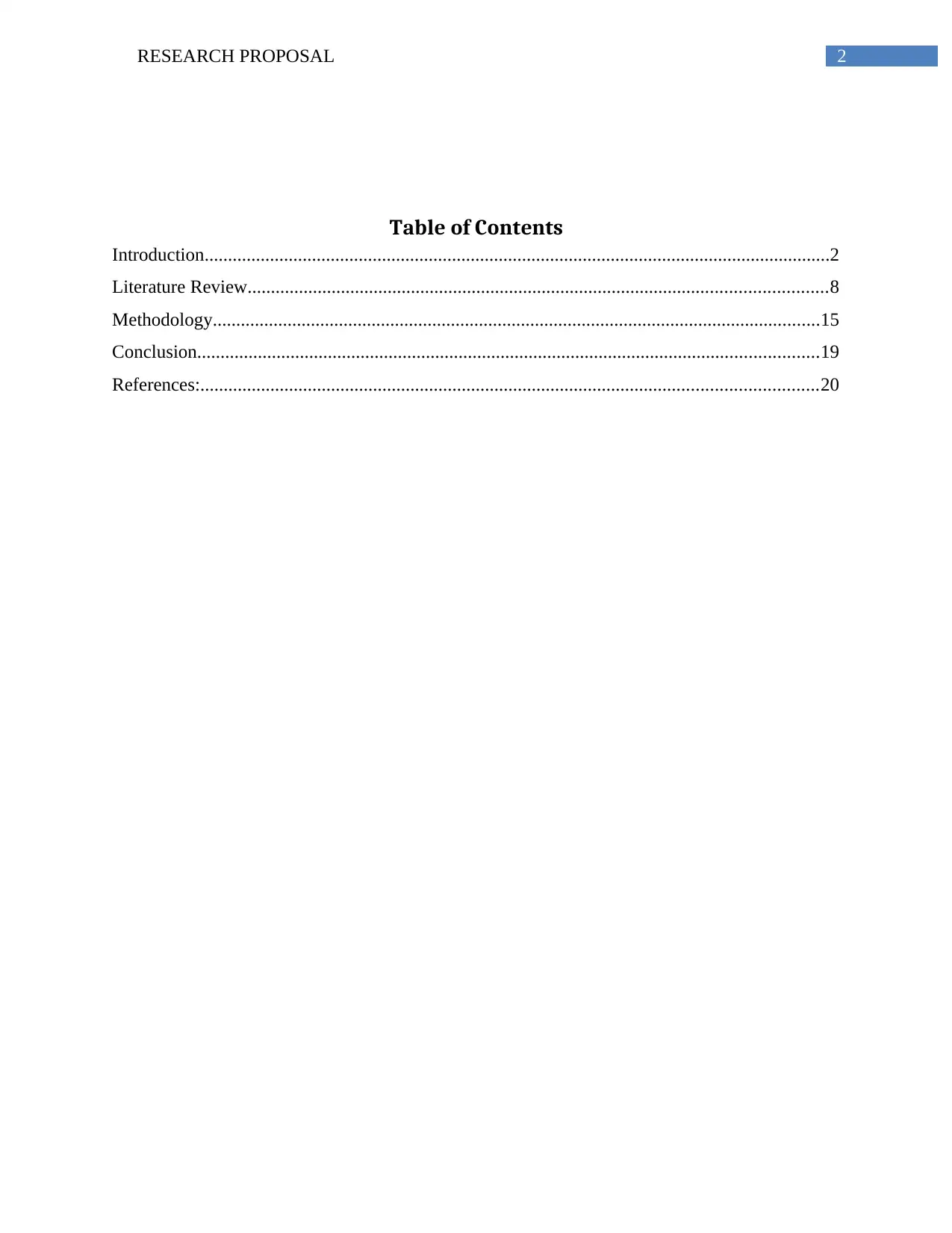
2RESEARCH PROPOSAL
Table of Contents
Introduction......................................................................................................................................2
Literature Review............................................................................................................................8
Methodology..................................................................................................................................15
Conclusion.....................................................................................................................................19
References:....................................................................................................................................20
Table of Contents
Introduction......................................................................................................................................2
Literature Review............................................................................................................................8
Methodology..................................................................................................................................15
Conclusion.....................................................................................................................................19
References:....................................................................................................................................20
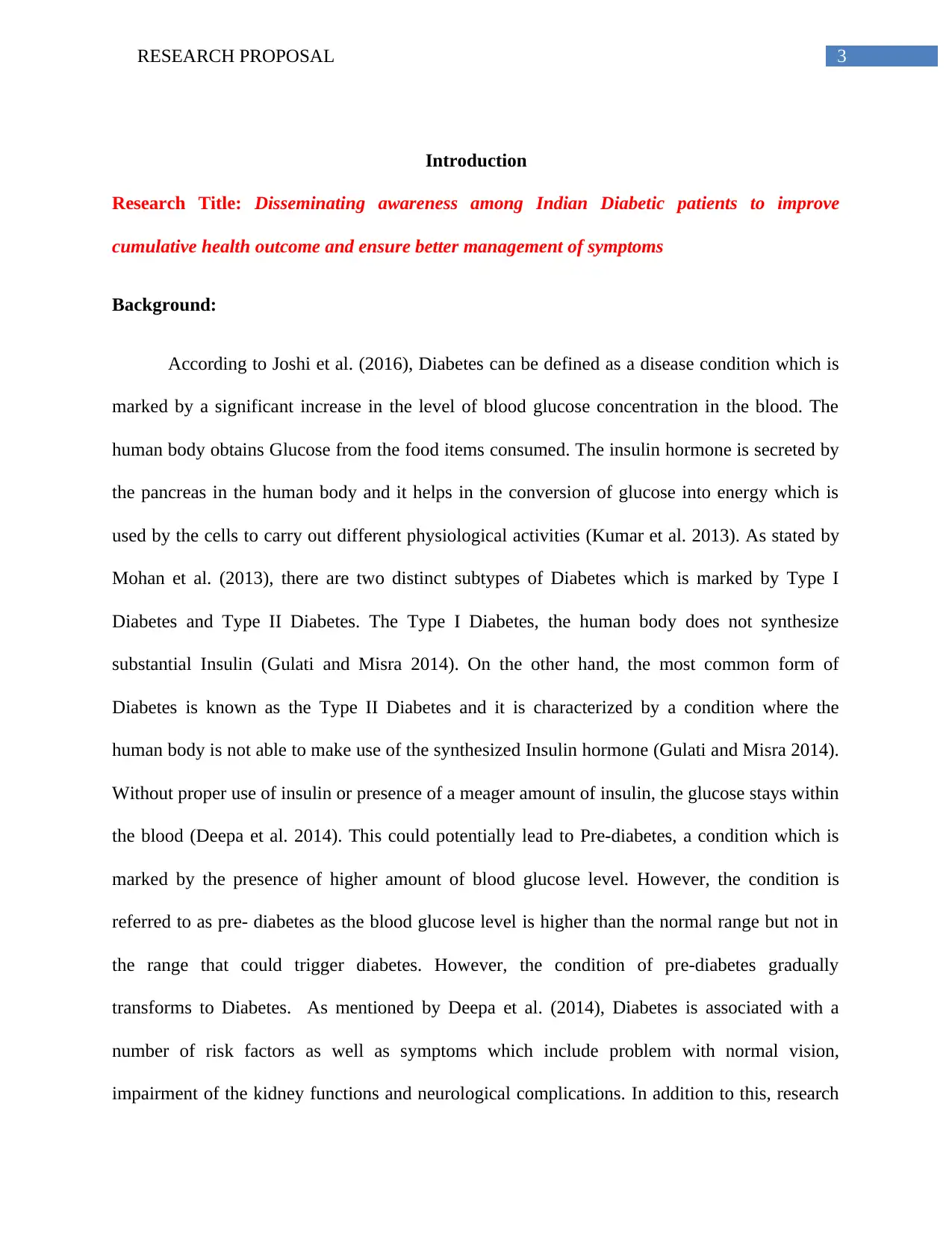
3RESEARCH PROPOSAL
Introduction
Research Title: Disseminating awareness among Indian Diabetic patients to improve
cumulative health outcome and ensure better management of symptoms
Background:
According to Joshi et al. (2016), Diabetes can be defined as a disease condition which is
marked by a significant increase in the level of blood glucose concentration in the blood. The
human body obtains Glucose from the food items consumed. The insulin hormone is secreted by
the pancreas in the human body and it helps in the conversion of glucose into energy which is
used by the cells to carry out different physiological activities (Kumar et al. 2013). As stated by
Mohan et al. (2013), there are two distinct subtypes of Diabetes which is marked by Type I
Diabetes and Type II Diabetes. The Type I Diabetes, the human body does not synthesize
substantial Insulin (Gulati and Misra 2014). On the other hand, the most common form of
Diabetes is known as the Type II Diabetes and it is characterized by a condition where the
human body is not able to make use of the synthesized Insulin hormone (Gulati and Misra 2014).
Without proper use of insulin or presence of a meager amount of insulin, the glucose stays within
the blood (Deepa et al. 2014). This could potentially lead to Pre-diabetes, a condition which is
marked by the presence of higher amount of blood glucose level. However, the condition is
referred to as pre- diabetes as the blood glucose level is higher than the normal range but not in
the range that could trigger diabetes. However, the condition of pre-diabetes gradually
transforms to Diabetes. As mentioned by Deepa et al. (2014), Diabetes is associated with a
number of risk factors as well as symptoms which include problem with normal vision,
impairment of the kidney functions and neurological complications. In addition to this, research
Introduction
Research Title: Disseminating awareness among Indian Diabetic patients to improve
cumulative health outcome and ensure better management of symptoms
Background:
According to Joshi et al. (2016), Diabetes can be defined as a disease condition which is
marked by a significant increase in the level of blood glucose concentration in the blood. The
human body obtains Glucose from the food items consumed. The insulin hormone is secreted by
the pancreas in the human body and it helps in the conversion of glucose into energy which is
used by the cells to carry out different physiological activities (Kumar et al. 2013). As stated by
Mohan et al. (2013), there are two distinct subtypes of Diabetes which is marked by Type I
Diabetes and Type II Diabetes. The Type I Diabetes, the human body does not synthesize
substantial Insulin (Gulati and Misra 2014). On the other hand, the most common form of
Diabetes is known as the Type II Diabetes and it is characterized by a condition where the
human body is not able to make use of the synthesized Insulin hormone (Gulati and Misra 2014).
Without proper use of insulin or presence of a meager amount of insulin, the glucose stays within
the blood (Deepa et al. 2014). This could potentially lead to Pre-diabetes, a condition which is
marked by the presence of higher amount of blood glucose level. However, the condition is
referred to as pre- diabetes as the blood glucose level is higher than the normal range but not in
the range that could trigger diabetes. However, the condition of pre-diabetes gradually
transforms to Diabetes. As mentioned by Deepa et al. (2014), Diabetes is associated with a
number of risk factors as well as symptoms which include problem with normal vision,
impairment of the kidney functions and neurological complications. In addition to this, research
Paraphrase This Document
Need a fresh take? Get an instant paraphrase of this document with our AI Paraphraser
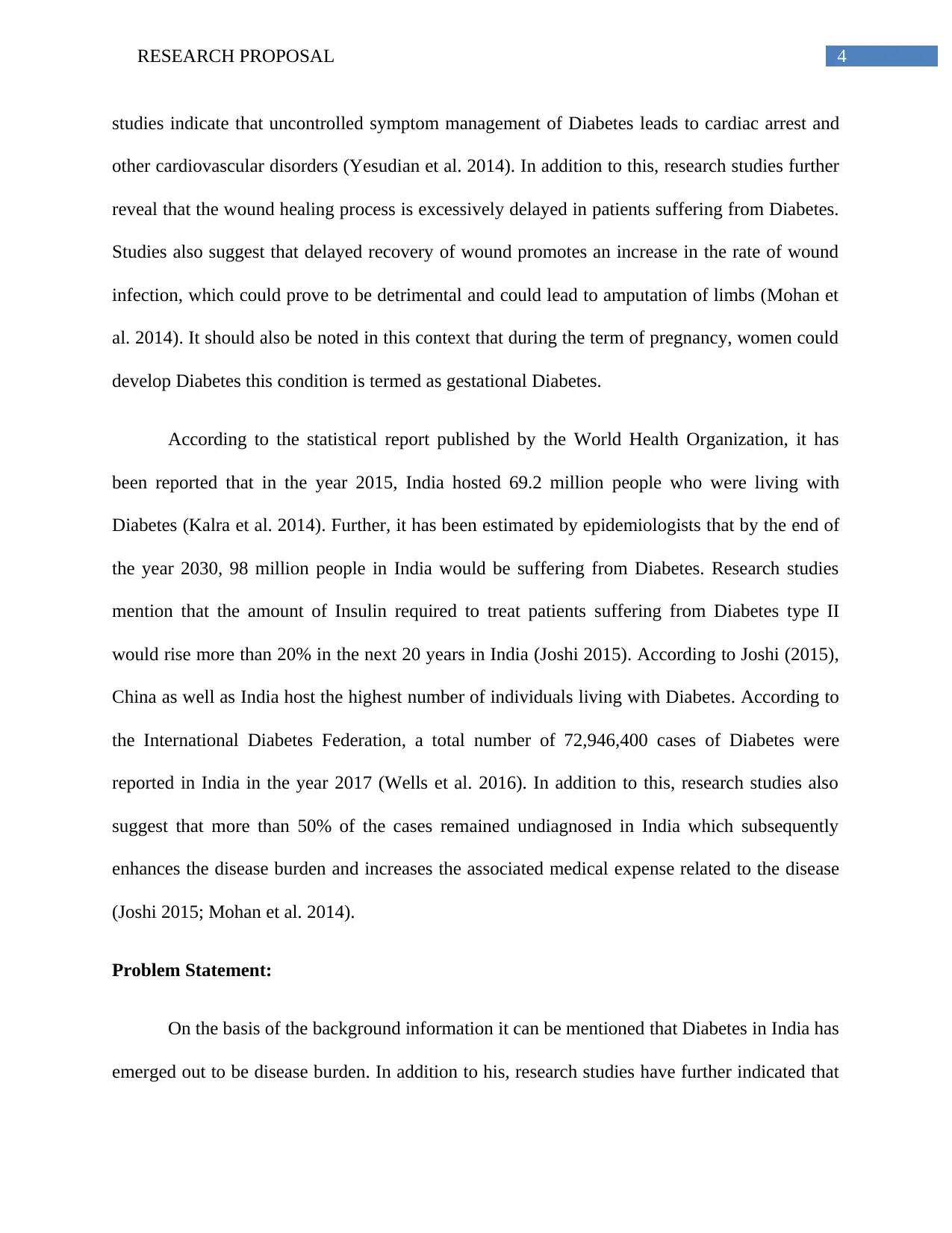
4RESEARCH PROPOSAL
studies indicate that uncontrolled symptom management of Diabetes leads to cardiac arrest and
other cardiovascular disorders (Yesudian et al. 2014). In addition to this, research studies further
reveal that the wound healing process is excessively delayed in patients suffering from Diabetes.
Studies also suggest that delayed recovery of wound promotes an increase in the rate of wound
infection, which could prove to be detrimental and could lead to amputation of limbs (Mohan et
al. 2014). It should also be noted in this context that during the term of pregnancy, women could
develop Diabetes this condition is termed as gestational Diabetes.
According to the statistical report published by the World Health Organization, it has
been reported that in the year 2015, India hosted 69.2 million people who were living with
Diabetes (Kalra et al. 2014). Further, it has been estimated by epidemiologists that by the end of
the year 2030, 98 million people in India would be suffering from Diabetes. Research studies
mention that the amount of Insulin required to treat patients suffering from Diabetes type II
would rise more than 20% in the next 20 years in India (Joshi 2015). According to Joshi (2015),
China as well as India host the highest number of individuals living with Diabetes. According to
the International Diabetes Federation, a total number of 72,946,400 cases of Diabetes were
reported in India in the year 2017 (Wells et al. 2016). In addition to this, research studies also
suggest that more than 50% of the cases remained undiagnosed in India which subsequently
enhances the disease burden and increases the associated medical expense related to the disease
(Joshi 2015; Mohan et al. 2014).
Problem Statement:
On the basis of the background information it can be mentioned that Diabetes in India has
emerged out to be disease burden. In addition to his, research studies have further indicated that
studies indicate that uncontrolled symptom management of Diabetes leads to cardiac arrest and
other cardiovascular disorders (Yesudian et al. 2014). In addition to this, research studies further
reveal that the wound healing process is excessively delayed in patients suffering from Diabetes.
Studies also suggest that delayed recovery of wound promotes an increase in the rate of wound
infection, which could prove to be detrimental and could lead to amputation of limbs (Mohan et
al. 2014). It should also be noted in this context that during the term of pregnancy, women could
develop Diabetes this condition is termed as gestational Diabetes.
According to the statistical report published by the World Health Organization, it has
been reported that in the year 2015, India hosted 69.2 million people who were living with
Diabetes (Kalra et al. 2014). Further, it has been estimated by epidemiologists that by the end of
the year 2030, 98 million people in India would be suffering from Diabetes. Research studies
mention that the amount of Insulin required to treat patients suffering from Diabetes type II
would rise more than 20% in the next 20 years in India (Joshi 2015). According to Joshi (2015),
China as well as India host the highest number of individuals living with Diabetes. According to
the International Diabetes Federation, a total number of 72,946,400 cases of Diabetes were
reported in India in the year 2017 (Wells et al. 2016). In addition to this, research studies also
suggest that more than 50% of the cases remained undiagnosed in India which subsequently
enhances the disease burden and increases the associated medical expense related to the disease
(Joshi 2015; Mohan et al. 2014).
Problem Statement:
On the basis of the background information it can be mentioned that Diabetes in India has
emerged out to be disease burden. In addition to his, research studies have further indicated that
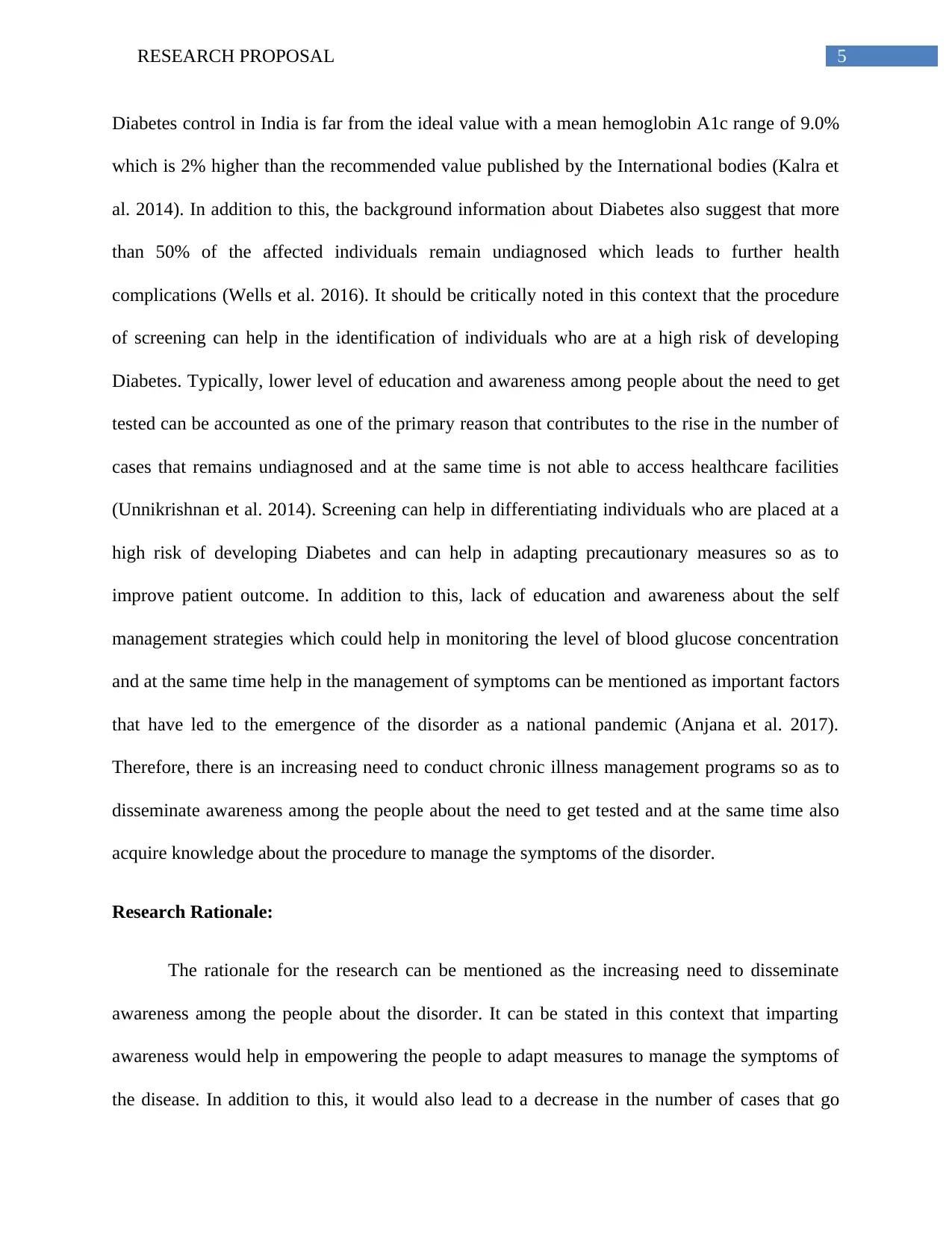
5RESEARCH PROPOSAL
Diabetes control in India is far from the ideal value with a mean hemoglobin A1c range of 9.0%
which is 2% higher than the recommended value published by the International bodies (Kalra et
al. 2014). In addition to this, the background information about Diabetes also suggest that more
than 50% of the affected individuals remain undiagnosed which leads to further health
complications (Wells et al. 2016). It should be critically noted in this context that the procedure
of screening can help in the identification of individuals who are at a high risk of developing
Diabetes. Typically, lower level of education and awareness among people about the need to get
tested can be accounted as one of the primary reason that contributes to the rise in the number of
cases that remains undiagnosed and at the same time is not able to access healthcare facilities
(Unnikrishnan et al. 2014). Screening can help in differentiating individuals who are placed at a
high risk of developing Diabetes and can help in adapting precautionary measures so as to
improve patient outcome. In addition to this, lack of education and awareness about the self
management strategies which could help in monitoring the level of blood glucose concentration
and at the same time help in the management of symptoms can be mentioned as important factors
that have led to the emergence of the disorder as a national pandemic (Anjana et al. 2017).
Therefore, there is an increasing need to conduct chronic illness management programs so as to
disseminate awareness among the people about the need to get tested and at the same time also
acquire knowledge about the procedure to manage the symptoms of the disorder.
Research Rationale:
The rationale for the research can be mentioned as the increasing need to disseminate
awareness among the people about the disorder. It can be stated in this context that imparting
awareness would help in empowering the people to adapt measures to manage the symptoms of
the disease. In addition to this, it would also lead to a decrease in the number of cases that go
Diabetes control in India is far from the ideal value with a mean hemoglobin A1c range of 9.0%
which is 2% higher than the recommended value published by the International bodies (Kalra et
al. 2014). In addition to this, the background information about Diabetes also suggest that more
than 50% of the affected individuals remain undiagnosed which leads to further health
complications (Wells et al. 2016). It should be critically noted in this context that the procedure
of screening can help in the identification of individuals who are at a high risk of developing
Diabetes. Typically, lower level of education and awareness among people about the need to get
tested can be accounted as one of the primary reason that contributes to the rise in the number of
cases that remains undiagnosed and at the same time is not able to access healthcare facilities
(Unnikrishnan et al. 2014). Screening can help in differentiating individuals who are placed at a
high risk of developing Diabetes and can help in adapting precautionary measures so as to
improve patient outcome. In addition to this, lack of education and awareness about the self
management strategies which could help in monitoring the level of blood glucose concentration
and at the same time help in the management of symptoms can be mentioned as important factors
that have led to the emergence of the disorder as a national pandemic (Anjana et al. 2017).
Therefore, there is an increasing need to conduct chronic illness management programs so as to
disseminate awareness among the people about the need to get tested and at the same time also
acquire knowledge about the procedure to manage the symptoms of the disorder.
Research Rationale:
The rationale for the research can be mentioned as the increasing need to disseminate
awareness among the people about the disorder. It can be stated in this context that imparting
awareness would help in empowering the people to adapt measures to manage the symptoms of
the disease. In addition to this, it would also lead to a decrease in the number of cases that go
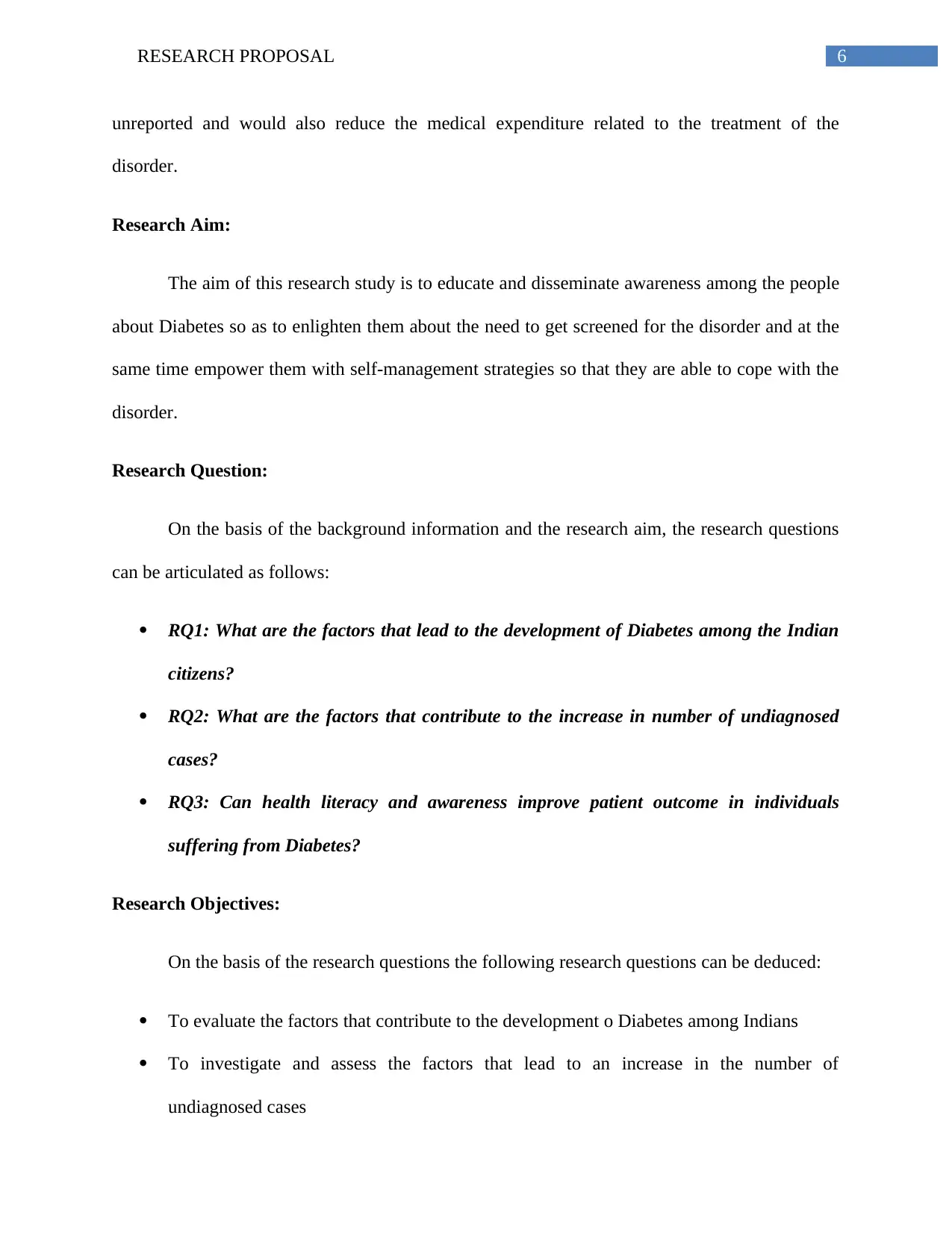
6RESEARCH PROPOSAL
unreported and would also reduce the medical expenditure related to the treatment of the
disorder.
Research Aim:
The aim of this research study is to educate and disseminate awareness among the people
about Diabetes so as to enlighten them about the need to get screened for the disorder and at the
same time empower them with self-management strategies so that they are able to cope with the
disorder.
Research Question:
On the basis of the background information and the research aim, the research questions
can be articulated as follows:
RQ1: What are the factors that lead to the development of Diabetes among the Indian
citizens?
RQ2: What are the factors that contribute to the increase in number of undiagnosed
cases?
RQ3: Can health literacy and awareness improve patient outcome in individuals
suffering from Diabetes?
Research Objectives:
On the basis of the research questions the following research questions can be deduced:
To evaluate the factors that contribute to the development o Diabetes among Indians
To investigate and assess the factors that lead to an increase in the number of
undiagnosed cases
unreported and would also reduce the medical expenditure related to the treatment of the
disorder.
Research Aim:
The aim of this research study is to educate and disseminate awareness among the people
about Diabetes so as to enlighten them about the need to get screened for the disorder and at the
same time empower them with self-management strategies so that they are able to cope with the
disorder.
Research Question:
On the basis of the background information and the research aim, the research questions
can be articulated as follows:
RQ1: What are the factors that lead to the development of Diabetes among the Indian
citizens?
RQ2: What are the factors that contribute to the increase in number of undiagnosed
cases?
RQ3: Can health literacy and awareness improve patient outcome in individuals
suffering from Diabetes?
Research Objectives:
On the basis of the research questions the following research questions can be deduced:
To evaluate the factors that contribute to the development o Diabetes among Indians
To investigate and assess the factors that lead to an increase in the number of
undiagnosed cases
Secure Best Marks with AI Grader
Need help grading? Try our AI Grader for instant feedback on your assignments.
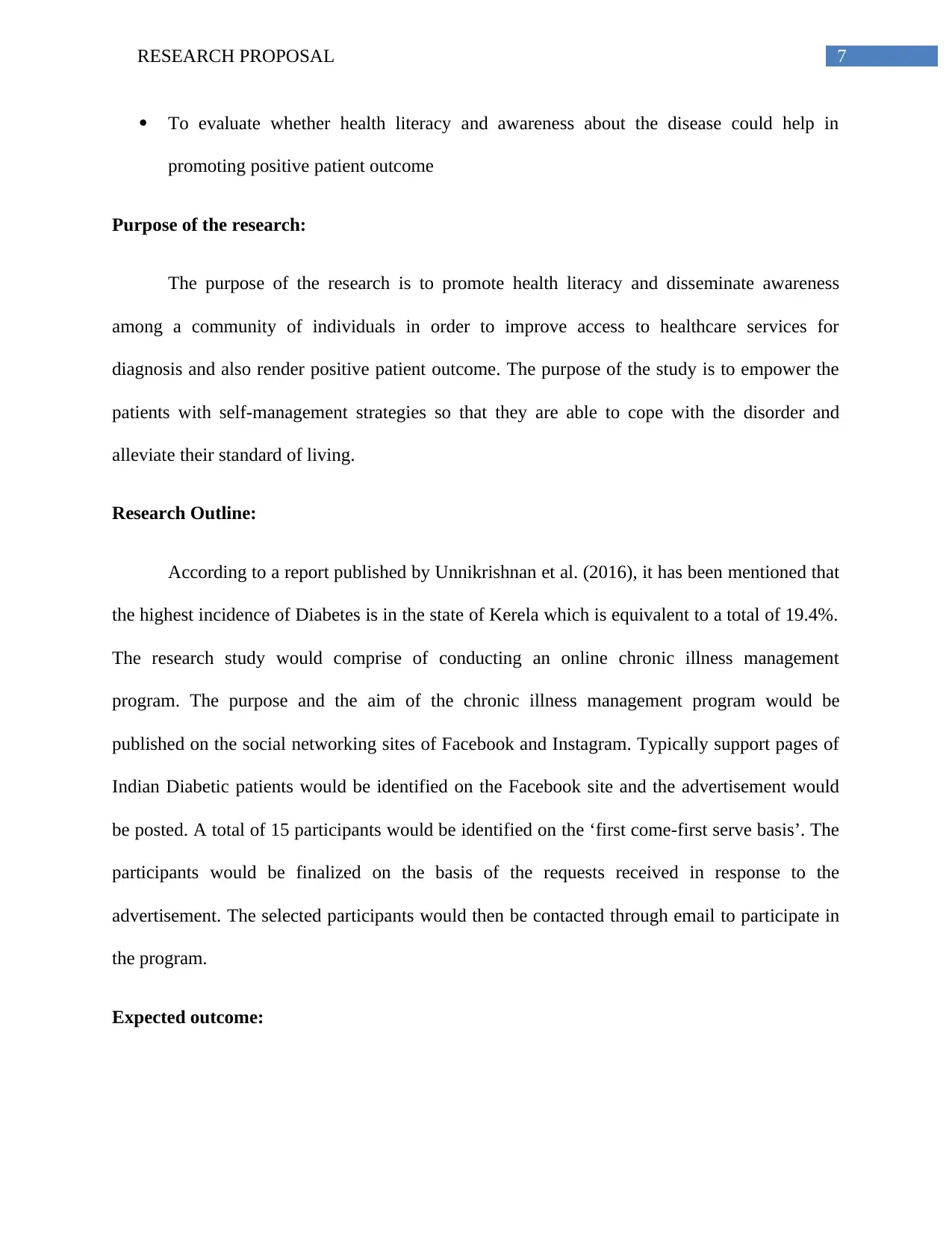
7RESEARCH PROPOSAL
To evaluate whether health literacy and awareness about the disease could help in
promoting positive patient outcome
Purpose of the research:
The purpose of the research is to promote health literacy and disseminate awareness
among a community of individuals in order to improve access to healthcare services for
diagnosis and also render positive patient outcome. The purpose of the study is to empower the
patients with self-management strategies so that they are able to cope with the disorder and
alleviate their standard of living.
Research Outline:
According to a report published by Unnikrishnan et al. (2016), it has been mentioned that
the highest incidence of Diabetes is in the state of Kerela which is equivalent to a total of 19.4%.
The research study would comprise of conducting an online chronic illness management
program. The purpose and the aim of the chronic illness management program would be
published on the social networking sites of Facebook and Instagram. Typically support pages of
Indian Diabetic patients would be identified on the Facebook site and the advertisement would
be posted. A total of 15 participants would be identified on the ‘first come-first serve basis’. The
participants would be finalized on the basis of the requests received in response to the
advertisement. The selected participants would then be contacted through email to participate in
the program.
Expected outcome:
To evaluate whether health literacy and awareness about the disease could help in
promoting positive patient outcome
Purpose of the research:
The purpose of the research is to promote health literacy and disseminate awareness
among a community of individuals in order to improve access to healthcare services for
diagnosis and also render positive patient outcome. The purpose of the study is to empower the
patients with self-management strategies so that they are able to cope with the disorder and
alleviate their standard of living.
Research Outline:
According to a report published by Unnikrishnan et al. (2016), it has been mentioned that
the highest incidence of Diabetes is in the state of Kerela which is equivalent to a total of 19.4%.
The research study would comprise of conducting an online chronic illness management
program. The purpose and the aim of the chronic illness management program would be
published on the social networking sites of Facebook and Instagram. Typically support pages of
Indian Diabetic patients would be identified on the Facebook site and the advertisement would
be posted. A total of 15 participants would be identified on the ‘first come-first serve basis’. The
participants would be finalized on the basis of the requests received in response to the
advertisement. The selected participants would then be contacted through email to participate in
the program.
Expected outcome:
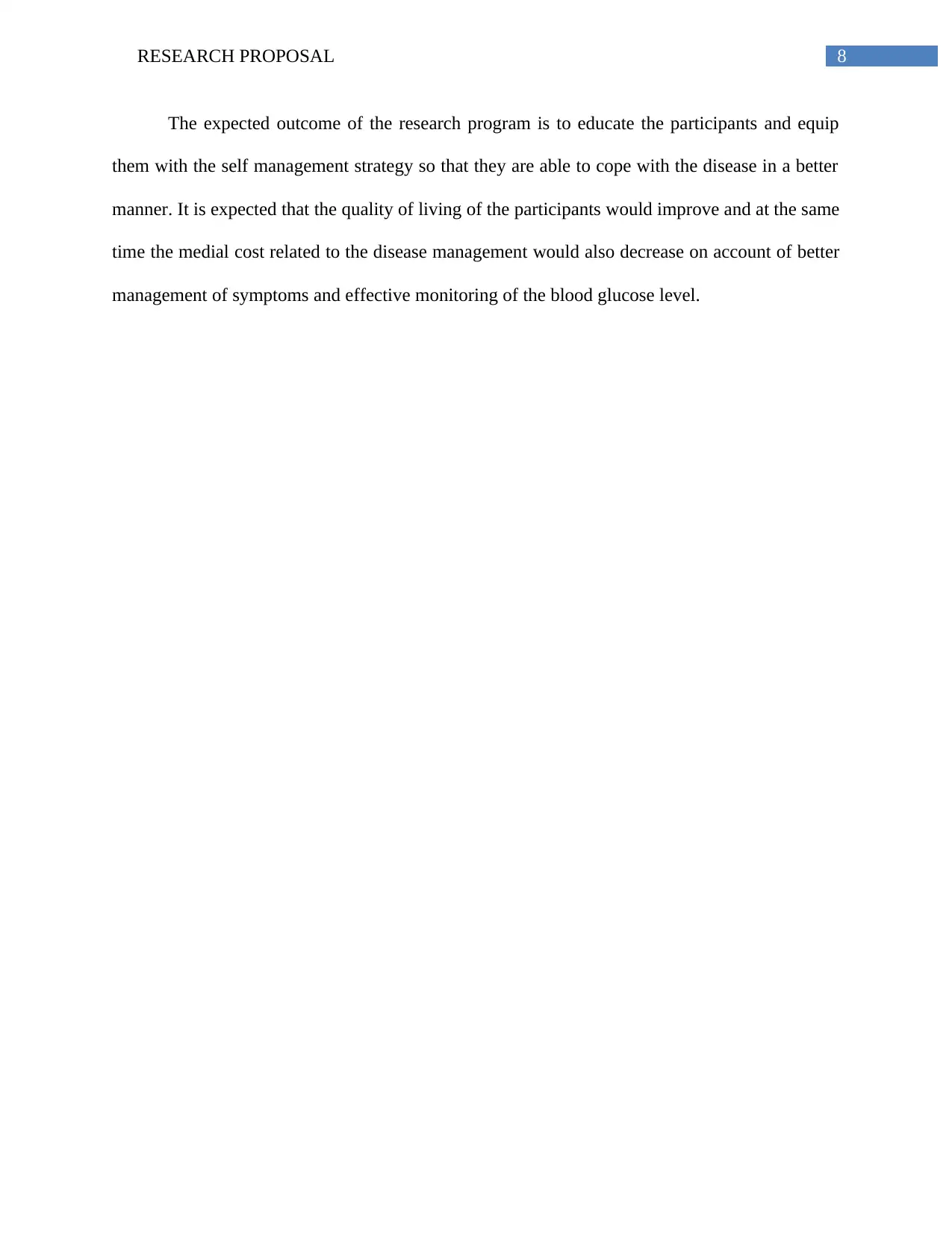
8RESEARCH PROPOSAL
The expected outcome of the research program is to educate the participants and equip
them with the self management strategy so that they are able to cope with the disease in a better
manner. It is expected that the quality of living of the participants would improve and at the same
time the medial cost related to the disease management would also decrease on account of better
management of symptoms and effective monitoring of the blood glucose level.
The expected outcome of the research program is to educate the participants and equip
them with the self management strategy so that they are able to cope with the disease in a better
manner. It is expected that the quality of living of the participants would improve and at the same
time the medial cost related to the disease management would also decrease on account of better
management of symptoms and effective monitoring of the blood glucose level.
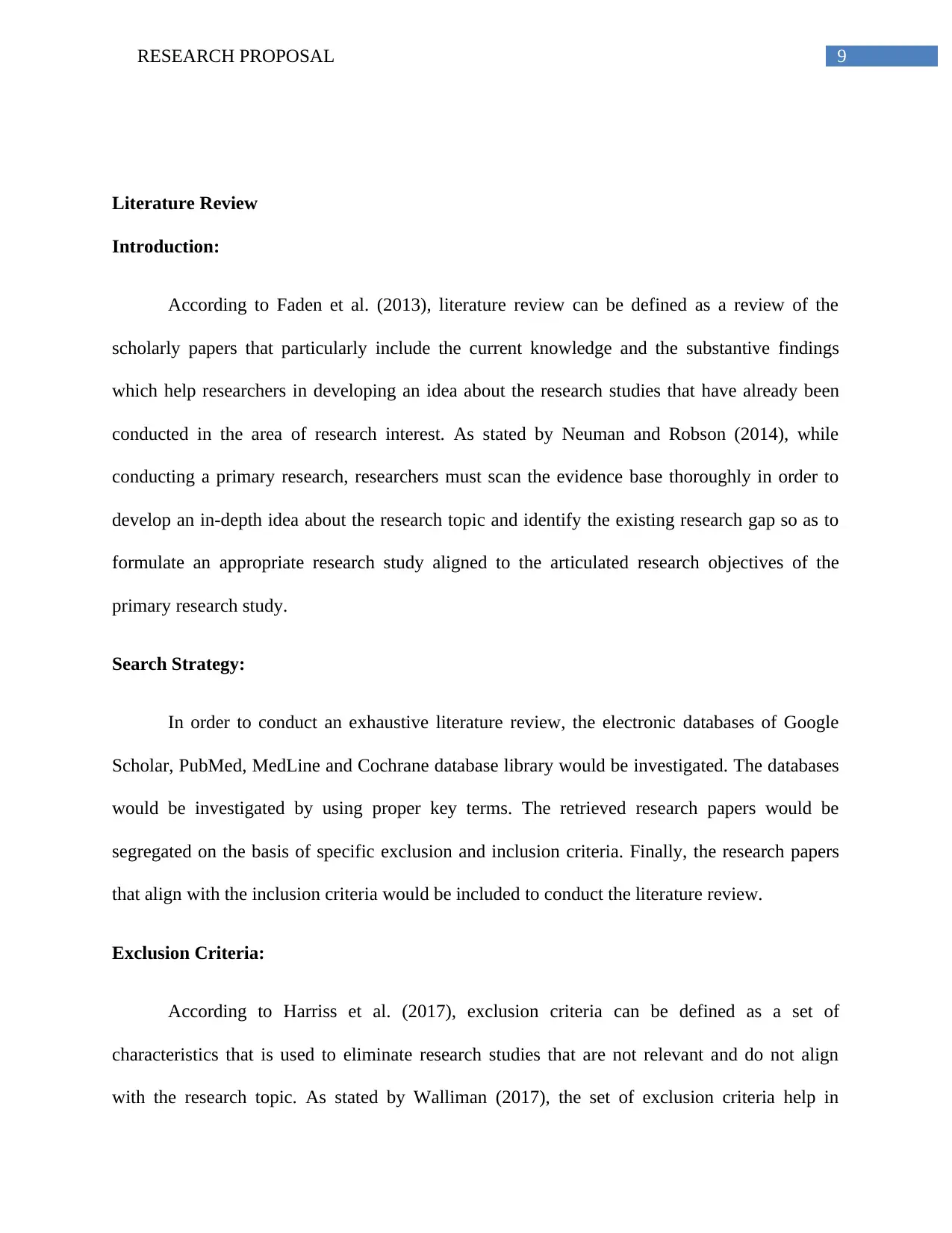
9RESEARCH PROPOSAL
Literature Review
Introduction:
According to Faden et al. (2013), literature review can be defined as a review of the
scholarly papers that particularly include the current knowledge and the substantive findings
which help researchers in developing an idea about the research studies that have already been
conducted in the area of research interest. As stated by Neuman and Robson (2014), while
conducting a primary research, researchers must scan the evidence base thoroughly in order to
develop an in-depth idea about the research topic and identify the existing research gap so as to
formulate an appropriate research study aligned to the articulated research objectives of the
primary research study.
Search Strategy:
In order to conduct an exhaustive literature review, the electronic databases of Google
Scholar, PubMed, MedLine and Cochrane database library would be investigated. The databases
would be investigated by using proper key terms. The retrieved research papers would be
segregated on the basis of specific exclusion and inclusion criteria. Finally, the research papers
that align with the inclusion criteria would be included to conduct the literature review.
Exclusion Criteria:
According to Harriss et al. (2017), exclusion criteria can be defined as a set of
characteristics that is used to eliminate research studies that are not relevant and do not align
with the research topic. As stated by Walliman (2017), the set of exclusion criteria help in
Literature Review
Introduction:
According to Faden et al. (2013), literature review can be defined as a review of the
scholarly papers that particularly include the current knowledge and the substantive findings
which help researchers in developing an idea about the research studies that have already been
conducted in the area of research interest. As stated by Neuman and Robson (2014), while
conducting a primary research, researchers must scan the evidence base thoroughly in order to
develop an in-depth idea about the research topic and identify the existing research gap so as to
formulate an appropriate research study aligned to the articulated research objectives of the
primary research study.
Search Strategy:
In order to conduct an exhaustive literature review, the electronic databases of Google
Scholar, PubMed, MedLine and Cochrane database library would be investigated. The databases
would be investigated by using proper key terms. The retrieved research papers would be
segregated on the basis of specific exclusion and inclusion criteria. Finally, the research papers
that align with the inclusion criteria would be included to conduct the literature review.
Exclusion Criteria:
According to Harriss et al. (2017), exclusion criteria can be defined as a set of
characteristics that is used to eliminate research studies that are not relevant and do not align
with the research topic. As stated by Walliman (2017), the set of exclusion criteria help in
Paraphrase This Document
Need a fresh take? Get an instant paraphrase of this document with our AI Paraphraser

10RESEARCH PROPOSAL
refining the search of scholarly literatures and helps in conducting a focused search of scholarly
literatures. The set of exclusion criteria that would be followed while conducting the search
would include the following:
Papers published in foreign languages other than English
Papers published prior to 2013
Papers that are completely accessible
Inclusion Criteria:
According to Lange et al. (2013), the set of inclusion criteria comprises of factors that are
used to retrieve relevant research studies. These factors help in filtering the most relevant
research papers that effectively address the articulated research objectives. In this case, the set of
inclusion criteria would comprise of the following:
Papers published in English
Papers published in between 2013 to 2018
Papers that are fully accessible
Key words:
Key words are basically short phrases and terms that are used while conducting a search
on the electronic databases. These short phrases are strongly aligned to the research question and
help in retrieving relevant research studies (Walliman 2017). In this case, the key words that
were used while conducting the research included the following:
refining the search of scholarly literatures and helps in conducting a focused search of scholarly
literatures. The set of exclusion criteria that would be followed while conducting the search
would include the following:
Papers published in foreign languages other than English
Papers published prior to 2013
Papers that are completely accessible
Inclusion Criteria:
According to Lange et al. (2013), the set of inclusion criteria comprises of factors that are
used to retrieve relevant research studies. These factors help in filtering the most relevant
research papers that effectively address the articulated research objectives. In this case, the set of
inclusion criteria would comprise of the following:
Papers published in English
Papers published in between 2013 to 2018
Papers that are fully accessible
Key words:
Key words are basically short phrases and terms that are used while conducting a search
on the electronic databases. These short phrases are strongly aligned to the research question and
help in retrieving relevant research studies (Walliman 2017). In this case, the key words that
were used while conducting the research included the following:
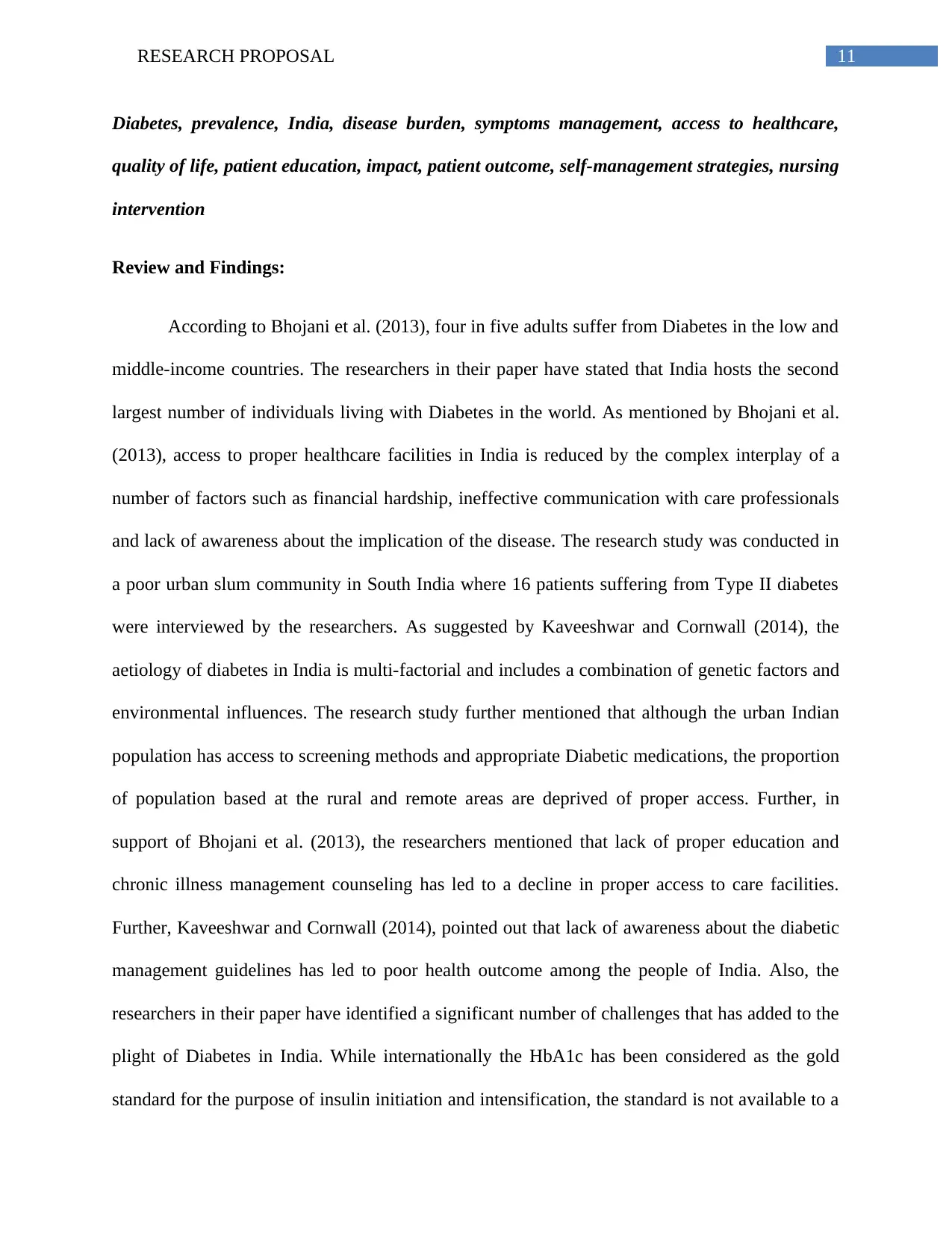
11RESEARCH PROPOSAL
Diabetes, prevalence, India, disease burden, symptoms management, access to healthcare,
quality of life, patient education, impact, patient outcome, self-management strategies, nursing
intervention
Review and Findings:
According to Bhojani et al. (2013), four in five adults suffer from Diabetes in the low and
middle-income countries. The researchers in their paper have stated that India hosts the second
largest number of individuals living with Diabetes in the world. As mentioned by Bhojani et al.
(2013), access to proper healthcare facilities in India is reduced by the complex interplay of a
number of factors such as financial hardship, ineffective communication with care professionals
and lack of awareness about the implication of the disease. The research study was conducted in
a poor urban slum community in South India where 16 patients suffering from Type II diabetes
were interviewed by the researchers. As suggested by Kaveeshwar and Cornwall (2014), the
aetiology of diabetes in India is multi-factorial and includes a combination of genetic factors and
environmental influences. The research study further mentioned that although the urban Indian
population has access to screening methods and appropriate Diabetic medications, the proportion
of population based at the rural and remote areas are deprived of proper access. Further, in
support of Bhojani et al. (2013), the researchers mentioned that lack of proper education and
chronic illness management counseling has led to a decline in proper access to care facilities.
Further, Kaveeshwar and Cornwall (2014), pointed out that lack of awareness about the diabetic
management guidelines has led to poor health outcome among the people of India. Also, the
researchers in their paper have identified a significant number of challenges that has added to the
plight of Diabetes in India. While internationally the HbA1c has been considered as the gold
standard for the purpose of insulin initiation and intensification, the standard is not available to a
Diabetes, prevalence, India, disease burden, symptoms management, access to healthcare,
quality of life, patient education, impact, patient outcome, self-management strategies, nursing
intervention
Review and Findings:
According to Bhojani et al. (2013), four in five adults suffer from Diabetes in the low and
middle-income countries. The researchers in their paper have stated that India hosts the second
largest number of individuals living with Diabetes in the world. As mentioned by Bhojani et al.
(2013), access to proper healthcare facilities in India is reduced by the complex interplay of a
number of factors such as financial hardship, ineffective communication with care professionals
and lack of awareness about the implication of the disease. The research study was conducted in
a poor urban slum community in South India where 16 patients suffering from Type II diabetes
were interviewed by the researchers. As suggested by Kaveeshwar and Cornwall (2014), the
aetiology of diabetes in India is multi-factorial and includes a combination of genetic factors and
environmental influences. The research study further mentioned that although the urban Indian
population has access to screening methods and appropriate Diabetic medications, the proportion
of population based at the rural and remote areas are deprived of proper access. Further, in
support of Bhojani et al. (2013), the researchers mentioned that lack of proper education and
chronic illness management counseling has led to a decline in proper access to care facilities.
Further, Kaveeshwar and Cornwall (2014), pointed out that lack of awareness about the diabetic
management guidelines has led to poor health outcome among the people of India. Also, the
researchers in their paper have identified a significant number of challenges that has added to the
plight of Diabetes in India. While internationally the HbA1c has been considered as the gold
standard for the purpose of insulin initiation and intensification, the standard is not available to a
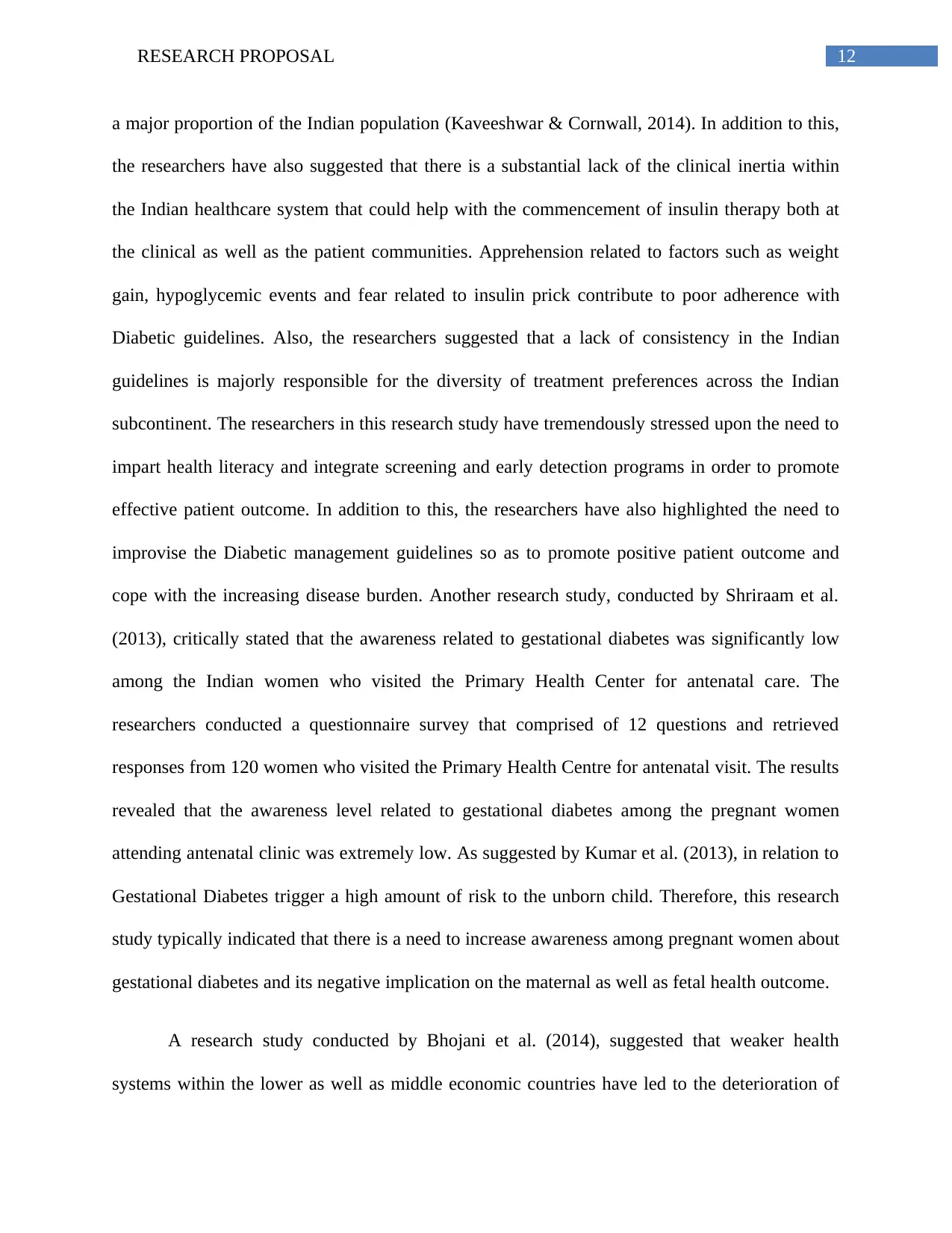
12RESEARCH PROPOSAL
a major proportion of the Indian population (Kaveeshwar & Cornwall, 2014). In addition to this,
the researchers have also suggested that there is a substantial lack of the clinical inertia within
the Indian healthcare system that could help with the commencement of insulin therapy both at
the clinical as well as the patient communities. Apprehension related to factors such as weight
gain, hypoglycemic events and fear related to insulin prick contribute to poor adherence with
Diabetic guidelines. Also, the researchers suggested that a lack of consistency in the Indian
guidelines is majorly responsible for the diversity of treatment preferences across the Indian
subcontinent. The researchers in this research study have tremendously stressed upon the need to
impart health literacy and integrate screening and early detection programs in order to promote
effective patient outcome. In addition to this, the researchers have also highlighted the need to
improvise the Diabetic management guidelines so as to promote positive patient outcome and
cope with the increasing disease burden. Another research study, conducted by Shriraam et al.
(2013), critically stated that the awareness related to gestational diabetes was significantly low
among the Indian women who visited the Primary Health Center for antenatal care. The
researchers conducted a questionnaire survey that comprised of 12 questions and retrieved
responses from 120 women who visited the Primary Health Centre for antenatal visit. The results
revealed that the awareness level related to gestational diabetes among the pregnant women
attending antenatal clinic was extremely low. As suggested by Kumar et al. (2013), in relation to
Gestational Diabetes trigger a high amount of risk to the unborn child. Therefore, this research
study typically indicated that there is a need to increase awareness among pregnant women about
gestational diabetes and its negative implication on the maternal as well as fetal health outcome.
A research study conducted by Bhojani et al. (2014), suggested that weaker health
systems within the lower as well as middle economic countries have led to the deterioration of
a major proportion of the Indian population (Kaveeshwar & Cornwall, 2014). In addition to this,
the researchers have also suggested that there is a substantial lack of the clinical inertia within
the Indian healthcare system that could help with the commencement of insulin therapy both at
the clinical as well as the patient communities. Apprehension related to factors such as weight
gain, hypoglycemic events and fear related to insulin prick contribute to poor adherence with
Diabetic guidelines. Also, the researchers suggested that a lack of consistency in the Indian
guidelines is majorly responsible for the diversity of treatment preferences across the Indian
subcontinent. The researchers in this research study have tremendously stressed upon the need to
impart health literacy and integrate screening and early detection programs in order to promote
effective patient outcome. In addition to this, the researchers have also highlighted the need to
improvise the Diabetic management guidelines so as to promote positive patient outcome and
cope with the increasing disease burden. Another research study, conducted by Shriraam et al.
(2013), critically stated that the awareness related to gestational diabetes was significantly low
among the Indian women who visited the Primary Health Center for antenatal care. The
researchers conducted a questionnaire survey that comprised of 12 questions and retrieved
responses from 120 women who visited the Primary Health Centre for antenatal visit. The results
revealed that the awareness level related to gestational diabetes among the pregnant women
attending antenatal clinic was extremely low. As suggested by Kumar et al. (2013), in relation to
Gestational Diabetes trigger a high amount of risk to the unborn child. Therefore, this research
study typically indicated that there is a need to increase awareness among pregnant women about
gestational diabetes and its negative implication on the maternal as well as fetal health outcome.
A research study conducted by Bhojani et al. (2014), suggested that weaker health
systems within the lower as well as middle economic countries have led to the deterioration of
Secure Best Marks with AI Grader
Need help grading? Try our AI Grader for instant feedback on your assignments.
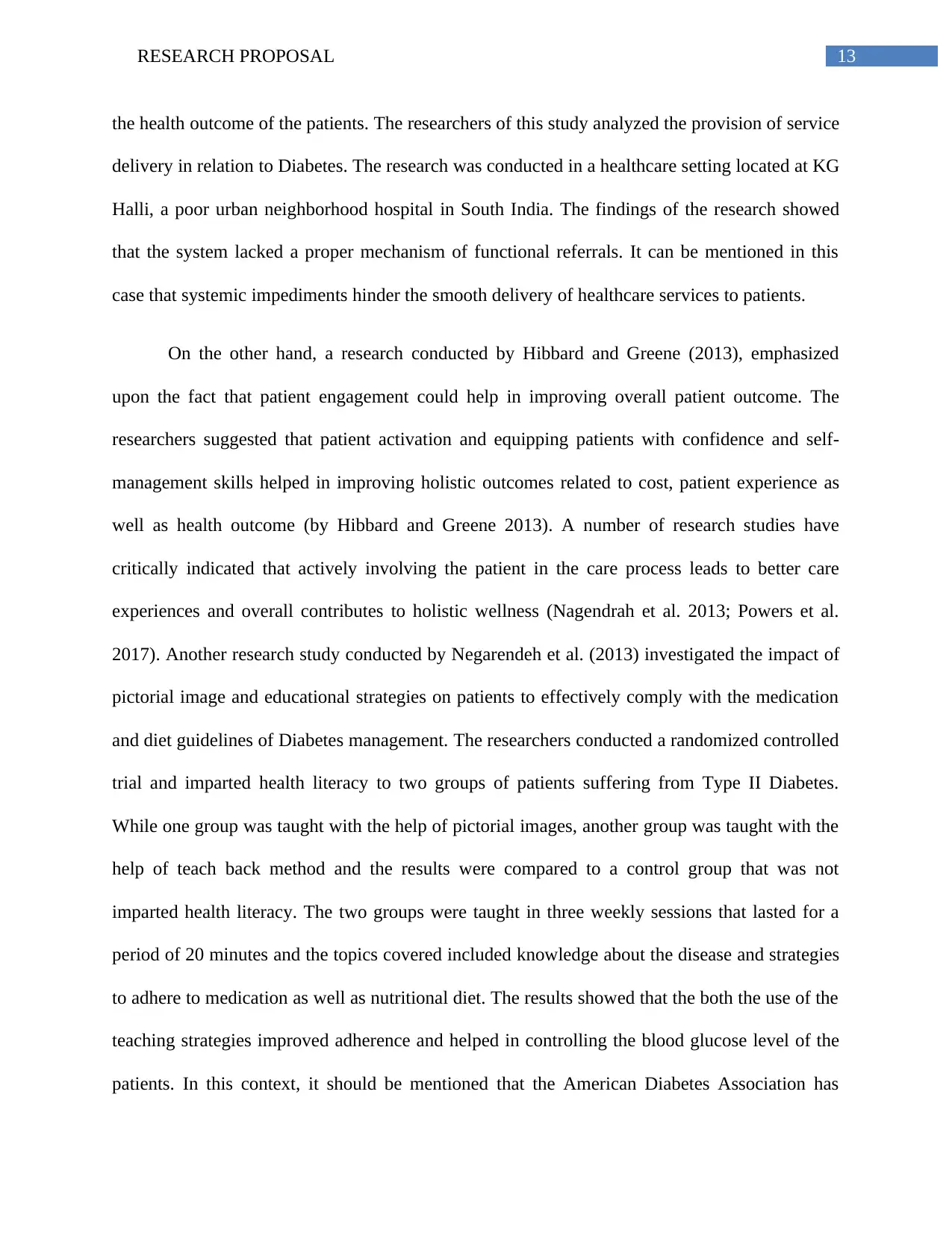
13RESEARCH PROPOSAL
the health outcome of the patients. The researchers of this study analyzed the provision of service
delivery in relation to Diabetes. The research was conducted in a healthcare setting located at KG
Halli, a poor urban neighborhood hospital in South India. The findings of the research showed
that the system lacked a proper mechanism of functional referrals. It can be mentioned in this
case that systemic impediments hinder the smooth delivery of healthcare services to patients.
On the other hand, a research conducted by Hibbard and Greene (2013), emphasized
upon the fact that patient engagement could help in improving overall patient outcome. The
researchers suggested that patient activation and equipping patients with confidence and self-
management skills helped in improving holistic outcomes related to cost, patient experience as
well as health outcome (by Hibbard and Greene 2013). A number of research studies have
critically indicated that actively involving the patient in the care process leads to better care
experiences and overall contributes to holistic wellness (Nagendrah et al. 2013; Powers et al.
2017). Another research study conducted by Negarendeh et al. (2013) investigated the impact of
pictorial image and educational strategies on patients to effectively comply with the medication
and diet guidelines of Diabetes management. The researchers conducted a randomized controlled
trial and imparted health literacy to two groups of patients suffering from Type II Diabetes.
While one group was taught with the help of pictorial images, another group was taught with the
help of teach back method and the results were compared to a control group that was not
imparted health literacy. The two groups were taught in three weekly sessions that lasted for a
period of 20 minutes and the topics covered included knowledge about the disease and strategies
to adhere to medication as well as nutritional diet. The results showed that the both the use of the
teaching strategies improved adherence and helped in controlling the blood glucose level of the
patients. In this context, it should be mentioned that the American Diabetes Association has
the health outcome of the patients. The researchers of this study analyzed the provision of service
delivery in relation to Diabetes. The research was conducted in a healthcare setting located at KG
Halli, a poor urban neighborhood hospital in South India. The findings of the research showed
that the system lacked a proper mechanism of functional referrals. It can be mentioned in this
case that systemic impediments hinder the smooth delivery of healthcare services to patients.
On the other hand, a research conducted by Hibbard and Greene (2013), emphasized
upon the fact that patient engagement could help in improving overall patient outcome. The
researchers suggested that patient activation and equipping patients with confidence and self-
management skills helped in improving holistic outcomes related to cost, patient experience as
well as health outcome (by Hibbard and Greene 2013). A number of research studies have
critically indicated that actively involving the patient in the care process leads to better care
experiences and overall contributes to holistic wellness (Nagendrah et al. 2013; Powers et al.
2017). Another research study conducted by Negarendeh et al. (2013) investigated the impact of
pictorial image and educational strategies on patients to effectively comply with the medication
and diet guidelines of Diabetes management. The researchers conducted a randomized controlled
trial and imparted health literacy to two groups of patients suffering from Type II Diabetes.
While one group was taught with the help of pictorial images, another group was taught with the
help of teach back method and the results were compared to a control group that was not
imparted health literacy. The two groups were taught in three weekly sessions that lasted for a
period of 20 minutes and the topics covered included knowledge about the disease and strategies
to adhere to medication as well as nutritional diet. The results showed that the both the use of the
teaching strategies improved adherence and helped in controlling the blood glucose level of the
patients. In this context, it should be mentioned that the American Diabetes Association has
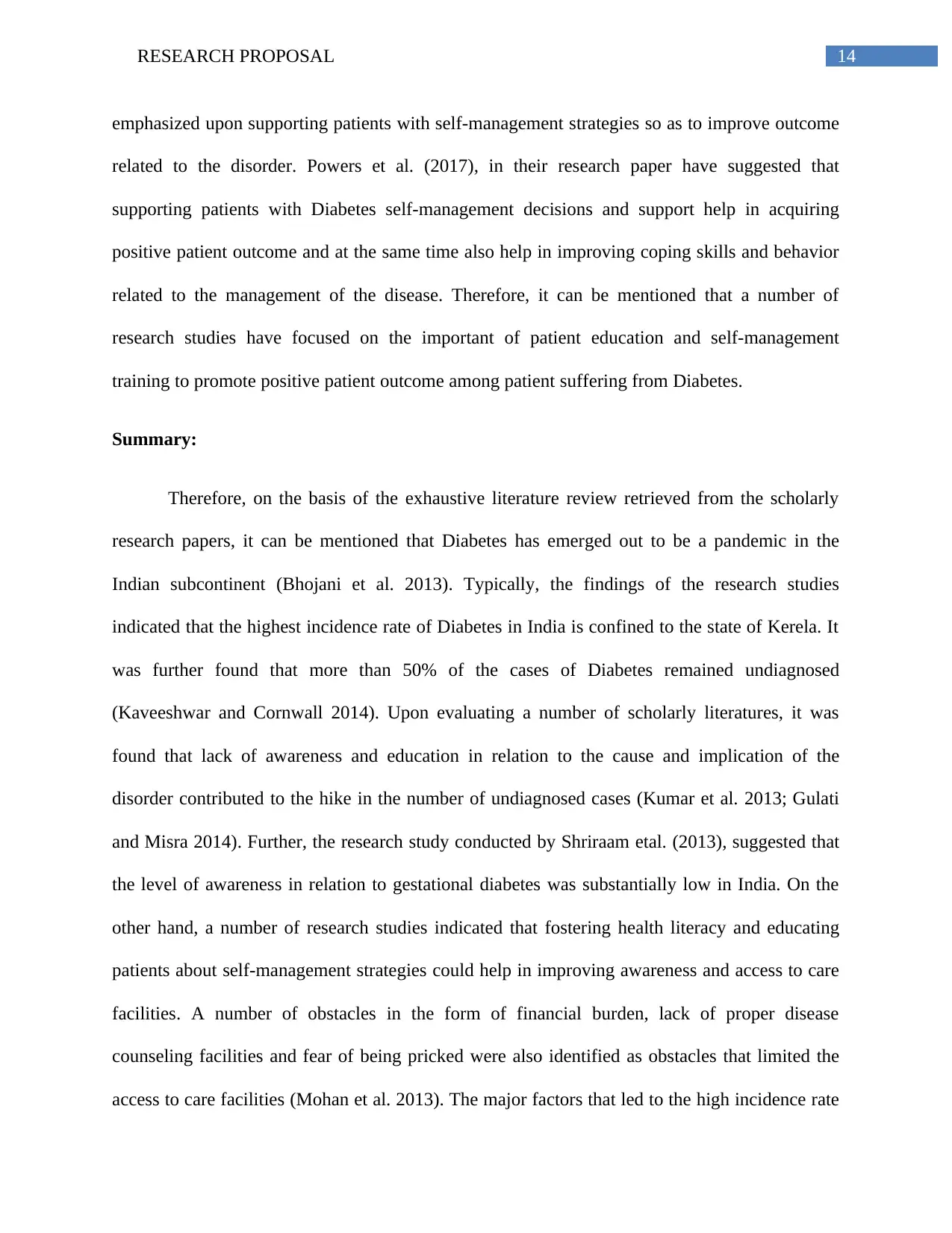
14RESEARCH PROPOSAL
emphasized upon supporting patients with self-management strategies so as to improve outcome
related to the disorder. Powers et al. (2017), in their research paper have suggested that
supporting patients with Diabetes self-management decisions and support help in acquiring
positive patient outcome and at the same time also help in improving coping skills and behavior
related to the management of the disease. Therefore, it can be mentioned that a number of
research studies have focused on the important of patient education and self-management
training to promote positive patient outcome among patient suffering from Diabetes.
Summary:
Therefore, on the basis of the exhaustive literature review retrieved from the scholarly
research papers, it can be mentioned that Diabetes has emerged out to be a pandemic in the
Indian subcontinent (Bhojani et al. 2013). Typically, the findings of the research studies
indicated that the highest incidence rate of Diabetes in India is confined to the state of Kerela. It
was further found that more than 50% of the cases of Diabetes remained undiagnosed
(Kaveeshwar and Cornwall 2014). Upon evaluating a number of scholarly literatures, it was
found that lack of awareness and education in relation to the cause and implication of the
disorder contributed to the hike in the number of undiagnosed cases (Kumar et al. 2013; Gulati
and Misra 2014). Further, the research study conducted by Shriraam etal. (2013), suggested that
the level of awareness in relation to gestational diabetes was substantially low in India. On the
other hand, a number of research studies indicated that fostering health literacy and educating
patients about self-management strategies could help in improving awareness and access to care
facilities. A number of obstacles in the form of financial burden, lack of proper disease
counseling facilities and fear of being pricked were also identified as obstacles that limited the
access to care facilities (Mohan et al. 2013). The major factors that led to the high incidence rate
emphasized upon supporting patients with self-management strategies so as to improve outcome
related to the disorder. Powers et al. (2017), in their research paper have suggested that
supporting patients with Diabetes self-management decisions and support help in acquiring
positive patient outcome and at the same time also help in improving coping skills and behavior
related to the management of the disease. Therefore, it can be mentioned that a number of
research studies have focused on the important of patient education and self-management
training to promote positive patient outcome among patient suffering from Diabetes.
Summary:
Therefore, on the basis of the exhaustive literature review retrieved from the scholarly
research papers, it can be mentioned that Diabetes has emerged out to be a pandemic in the
Indian subcontinent (Bhojani et al. 2013). Typically, the findings of the research studies
indicated that the highest incidence rate of Diabetes in India is confined to the state of Kerela. It
was further found that more than 50% of the cases of Diabetes remained undiagnosed
(Kaveeshwar and Cornwall 2014). Upon evaluating a number of scholarly literatures, it was
found that lack of awareness and education in relation to the cause and implication of the
disorder contributed to the hike in the number of undiagnosed cases (Kumar et al. 2013; Gulati
and Misra 2014). Further, the research study conducted by Shriraam etal. (2013), suggested that
the level of awareness in relation to gestational diabetes was substantially low in India. On the
other hand, a number of research studies indicated that fostering health literacy and educating
patients about self-management strategies could help in improving awareness and access to care
facilities. A number of obstacles in the form of financial burden, lack of proper disease
counseling facilities and fear of being pricked were also identified as obstacles that limited the
access to care facilities (Mohan et al. 2013). The major factors that led to the high incidence rate
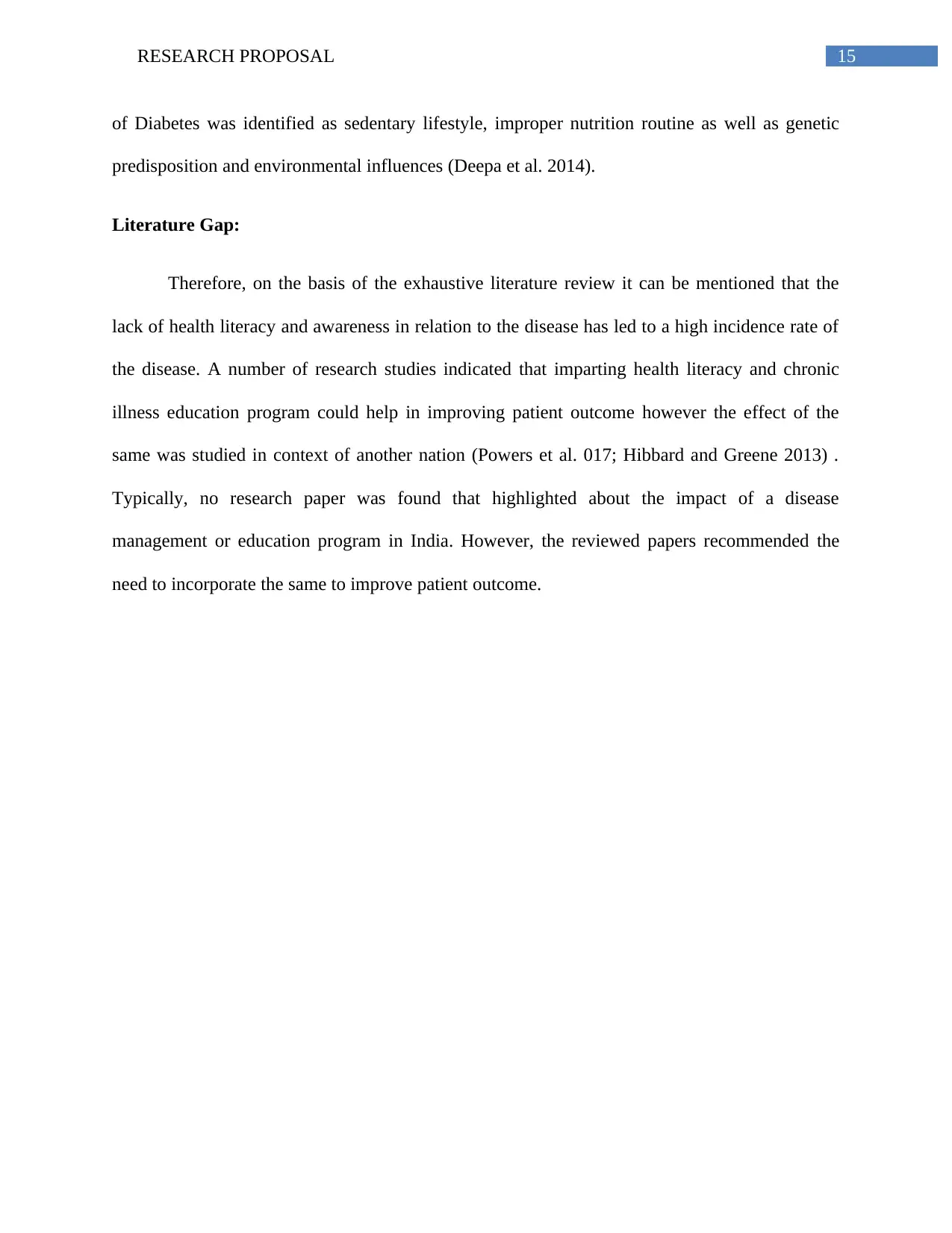
15RESEARCH PROPOSAL
of Diabetes was identified as sedentary lifestyle, improper nutrition routine as well as genetic
predisposition and environmental influences (Deepa et al. 2014).
Literature Gap:
Therefore, on the basis of the exhaustive literature review it can be mentioned that the
lack of health literacy and awareness in relation to the disease has led to a high incidence rate of
the disease. A number of research studies indicated that imparting health literacy and chronic
illness education program could help in improving patient outcome however the effect of the
same was studied in context of another nation (Powers et al. 017; Hibbard and Greene 2013) .
Typically, no research paper was found that highlighted about the impact of a disease
management or education program in India. However, the reviewed papers recommended the
need to incorporate the same to improve patient outcome.
of Diabetes was identified as sedentary lifestyle, improper nutrition routine as well as genetic
predisposition and environmental influences (Deepa et al. 2014).
Literature Gap:
Therefore, on the basis of the exhaustive literature review it can be mentioned that the
lack of health literacy and awareness in relation to the disease has led to a high incidence rate of
the disease. A number of research studies indicated that imparting health literacy and chronic
illness education program could help in improving patient outcome however the effect of the
same was studied in context of another nation (Powers et al. 017; Hibbard and Greene 2013) .
Typically, no research paper was found that highlighted about the impact of a disease
management or education program in India. However, the reviewed papers recommended the
need to incorporate the same to improve patient outcome.
Paraphrase This Document
Need a fresh take? Get an instant paraphrase of this document with our AI Paraphraser

16RESEARCH PROPOSAL
Methodology
Introduction:
Methodology forms the most important aspect while conducting a research. This segment
of the research generally comes after the review section and based upon the understanding of the
evidence base, the researcher adapts a research design to proceed with the research study (Lange
et al. 2013).
Research Design:
In order to address the research objectives of the study, a qualitative research design
would be adapted. An online education program would be conducted by the researcher that
would comprise of teaching a total of 15 participants about the disease with the help of a power
point presentation. Also, the researcher would teach 2 self-management interventions to the
participants by means of a video tutorial. In order to evaluate the research outcome, the
researcher would conduct telephonic interviews with the participants to obtain feedback and
analyze the findings by means of thematic data analysis.
Research Setting:
The research study would be conducted online on a Facebook page that hosts a
community of Diabetic patients who are Indian citizens. The research setting would therefore
remain unchanged both for the researcher as well as the participant.
Methodology
Introduction:
Methodology forms the most important aspect while conducting a research. This segment
of the research generally comes after the review section and based upon the understanding of the
evidence base, the researcher adapts a research design to proceed with the research study (Lange
et al. 2013).
Research Design:
In order to address the research objectives of the study, a qualitative research design
would be adapted. An online education program would be conducted by the researcher that
would comprise of teaching a total of 15 participants about the disease with the help of a power
point presentation. Also, the researcher would teach 2 self-management interventions to the
participants by means of a video tutorial. In order to evaluate the research outcome, the
researcher would conduct telephonic interviews with the participants to obtain feedback and
analyze the findings by means of thematic data analysis.
Research Setting:
The research study would be conducted online on a Facebook page that hosts a
community of Diabetic patients who are Indian citizens. The research setting would therefore
remain unchanged both for the researcher as well as the participant.
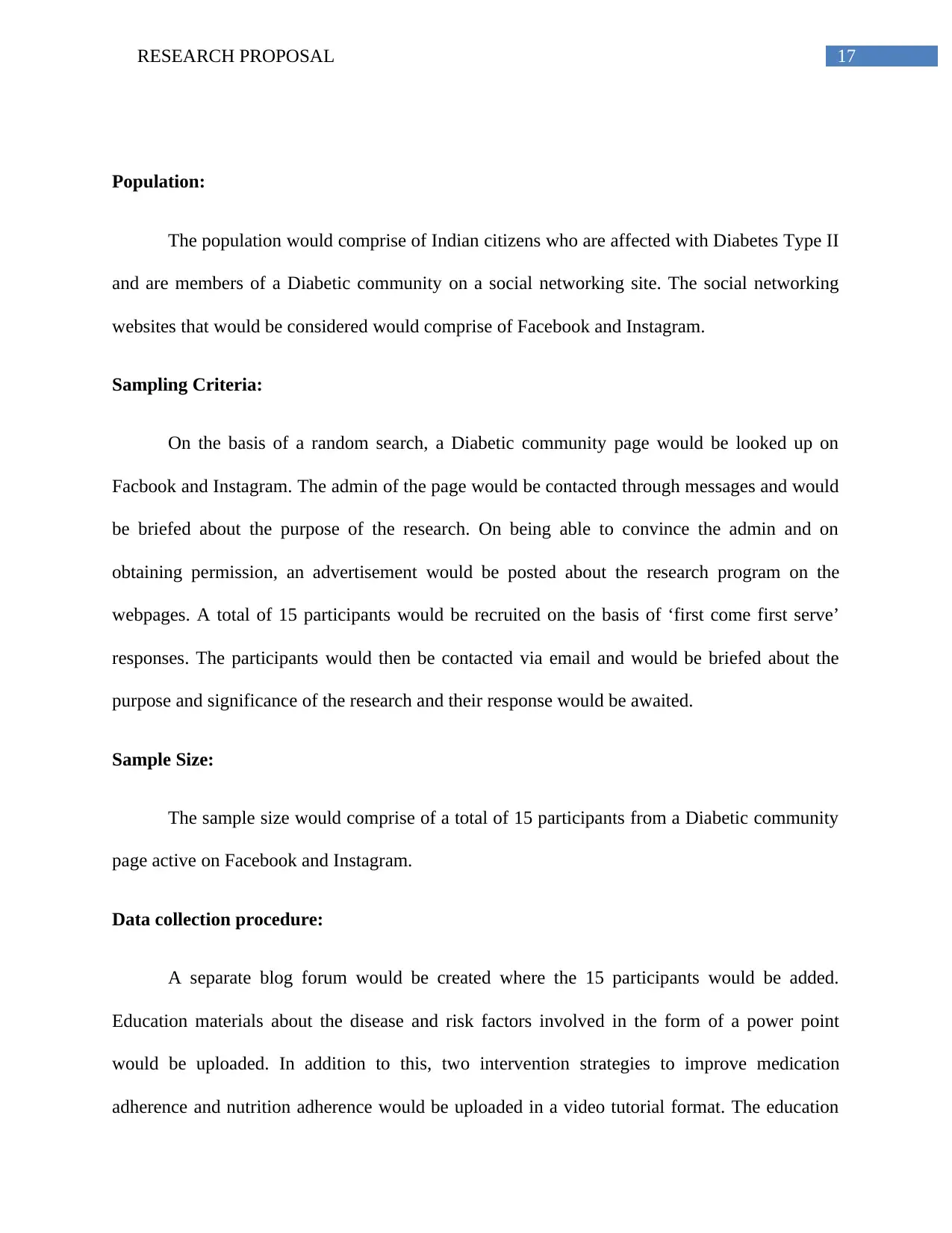
17RESEARCH PROPOSAL
Population:
The population would comprise of Indian citizens who are affected with Diabetes Type II
and are members of a Diabetic community on a social networking site. The social networking
websites that would be considered would comprise of Facebook and Instagram.
Sampling Criteria:
On the basis of a random search, a Diabetic community page would be looked up on
Facbook and Instagram. The admin of the page would be contacted through messages and would
be briefed about the purpose of the research. On being able to convince the admin and on
obtaining permission, an advertisement would be posted about the research program on the
webpages. A total of 15 participants would be recruited on the basis of ‘first come first serve’
responses. The participants would then be contacted via email and would be briefed about the
purpose and significance of the research and their response would be awaited.
Sample Size:
The sample size would comprise of a total of 15 participants from a Diabetic community
page active on Facebook and Instagram.
Data collection procedure:
A separate blog forum would be created where the 15 participants would be added.
Education materials about the disease and risk factors involved in the form of a power point
would be uploaded. In addition to this, two intervention strategies to improve medication
adherence and nutrition adherence would be uploaded in a video tutorial format. The education
Population:
The population would comprise of Indian citizens who are affected with Diabetes Type II
and are members of a Diabetic community on a social networking site. The social networking
websites that would be considered would comprise of Facebook and Instagram.
Sampling Criteria:
On the basis of a random search, a Diabetic community page would be looked up on
Facbook and Instagram. The admin of the page would be contacted through messages and would
be briefed about the purpose of the research. On being able to convince the admin and on
obtaining permission, an advertisement would be posted about the research program on the
webpages. A total of 15 participants would be recruited on the basis of ‘first come first serve’
responses. The participants would then be contacted via email and would be briefed about the
purpose and significance of the research and their response would be awaited.
Sample Size:
The sample size would comprise of a total of 15 participants from a Diabetic community
page active on Facebook and Instagram.
Data collection procedure:
A separate blog forum would be created where the 15 participants would be added.
Education materials about the disease and risk factors involved in the form of a power point
would be uploaded. In addition to this, two intervention strategies to improve medication
adherence and nutrition adherence would be uploaded in a video tutorial format. The education
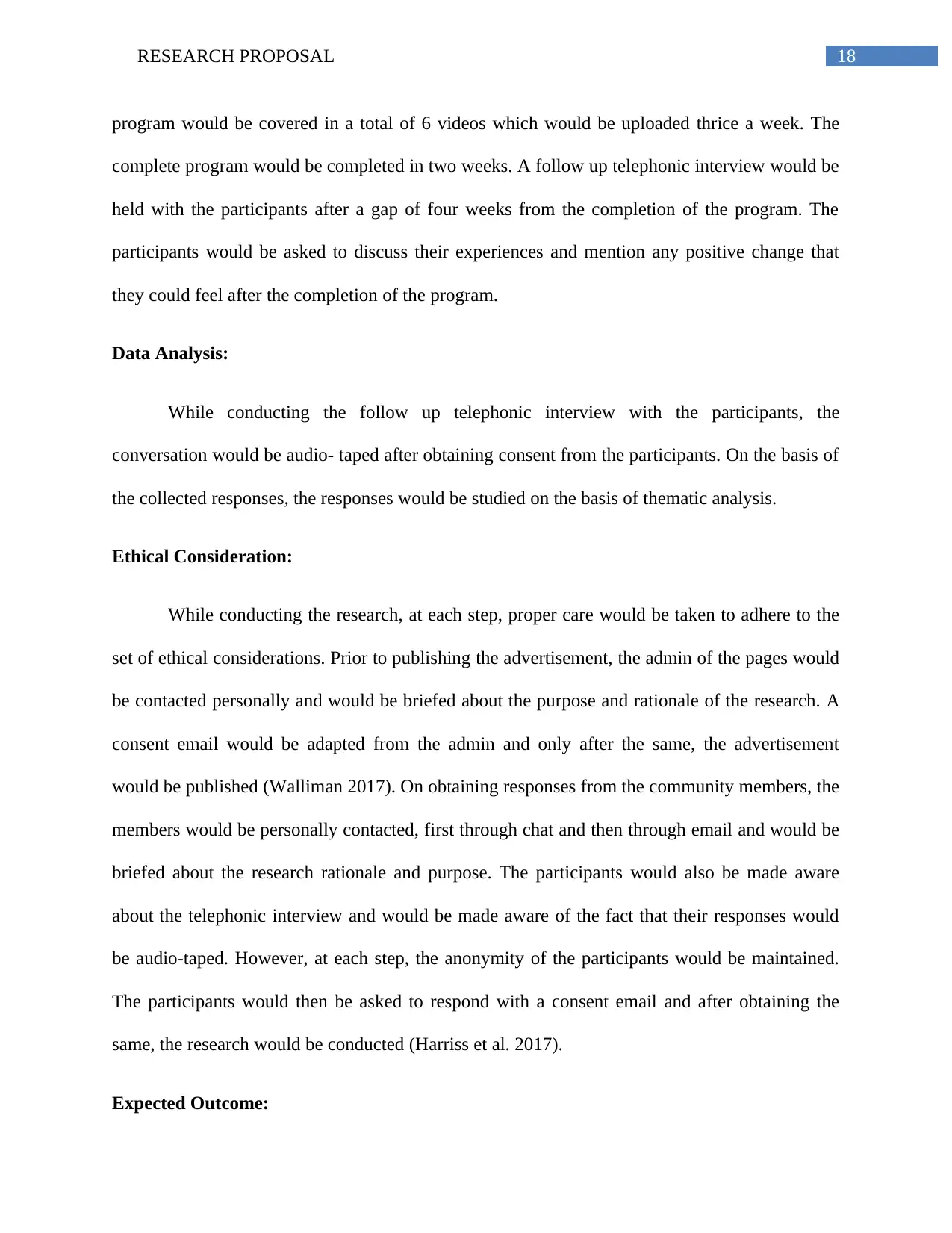
18RESEARCH PROPOSAL
program would be covered in a total of 6 videos which would be uploaded thrice a week. The
complete program would be completed in two weeks. A follow up telephonic interview would be
held with the participants after a gap of four weeks from the completion of the program. The
participants would be asked to discuss their experiences and mention any positive change that
they could feel after the completion of the program.
Data Analysis:
While conducting the follow up telephonic interview with the participants, the
conversation would be audio- taped after obtaining consent from the participants. On the basis of
the collected responses, the responses would be studied on the basis of thematic analysis.
Ethical Consideration:
While conducting the research, at each step, proper care would be taken to adhere to the
set of ethical considerations. Prior to publishing the advertisement, the admin of the pages would
be contacted personally and would be briefed about the purpose and rationale of the research. A
consent email would be adapted from the admin and only after the same, the advertisement
would be published (Walliman 2017). On obtaining responses from the community members, the
members would be personally contacted, first through chat and then through email and would be
briefed about the research rationale and purpose. The participants would also be made aware
about the telephonic interview and would be made aware of the fact that their responses would
be audio-taped. However, at each step, the anonymity of the participants would be maintained.
The participants would then be asked to respond with a consent email and after obtaining the
same, the research would be conducted (Harriss et al. 2017).
Expected Outcome:
program would be covered in a total of 6 videos which would be uploaded thrice a week. The
complete program would be completed in two weeks. A follow up telephonic interview would be
held with the participants after a gap of four weeks from the completion of the program. The
participants would be asked to discuss their experiences and mention any positive change that
they could feel after the completion of the program.
Data Analysis:
While conducting the follow up telephonic interview with the participants, the
conversation would be audio- taped after obtaining consent from the participants. On the basis of
the collected responses, the responses would be studied on the basis of thematic analysis.
Ethical Consideration:
While conducting the research, at each step, proper care would be taken to adhere to the
set of ethical considerations. Prior to publishing the advertisement, the admin of the pages would
be contacted personally and would be briefed about the purpose and rationale of the research. A
consent email would be adapted from the admin and only after the same, the advertisement
would be published (Walliman 2017). On obtaining responses from the community members, the
members would be personally contacted, first through chat and then through email and would be
briefed about the research rationale and purpose. The participants would also be made aware
about the telephonic interview and would be made aware of the fact that their responses would
be audio-taped. However, at each step, the anonymity of the participants would be maintained.
The participants would then be asked to respond with a consent email and after obtaining the
same, the research would be conducted (Harriss et al. 2017).
Expected Outcome:
Secure Best Marks with AI Grader
Need help grading? Try our AI Grader for instant feedback on your assignments.
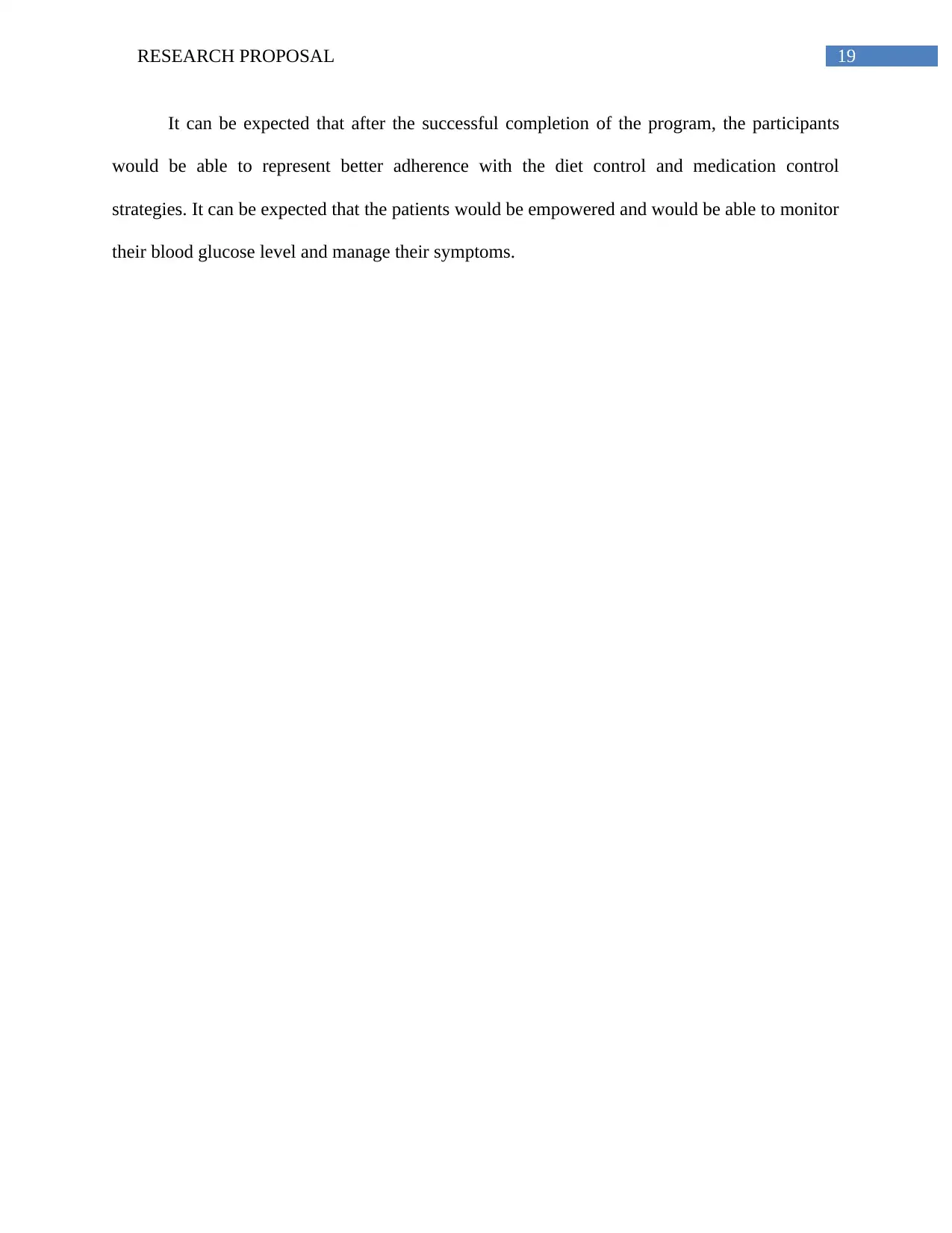
19RESEARCH PROPOSAL
It can be expected that after the successful completion of the program, the participants
would be able to represent better adherence with the diet control and medication control
strategies. It can be expected that the patients would be empowered and would be able to monitor
their blood glucose level and manage their symptoms.
It can be expected that after the successful completion of the program, the participants
would be able to represent better adherence with the diet control and medication control
strategies. It can be expected that the patients would be empowered and would be able to monitor
their blood glucose level and manage their symptoms.
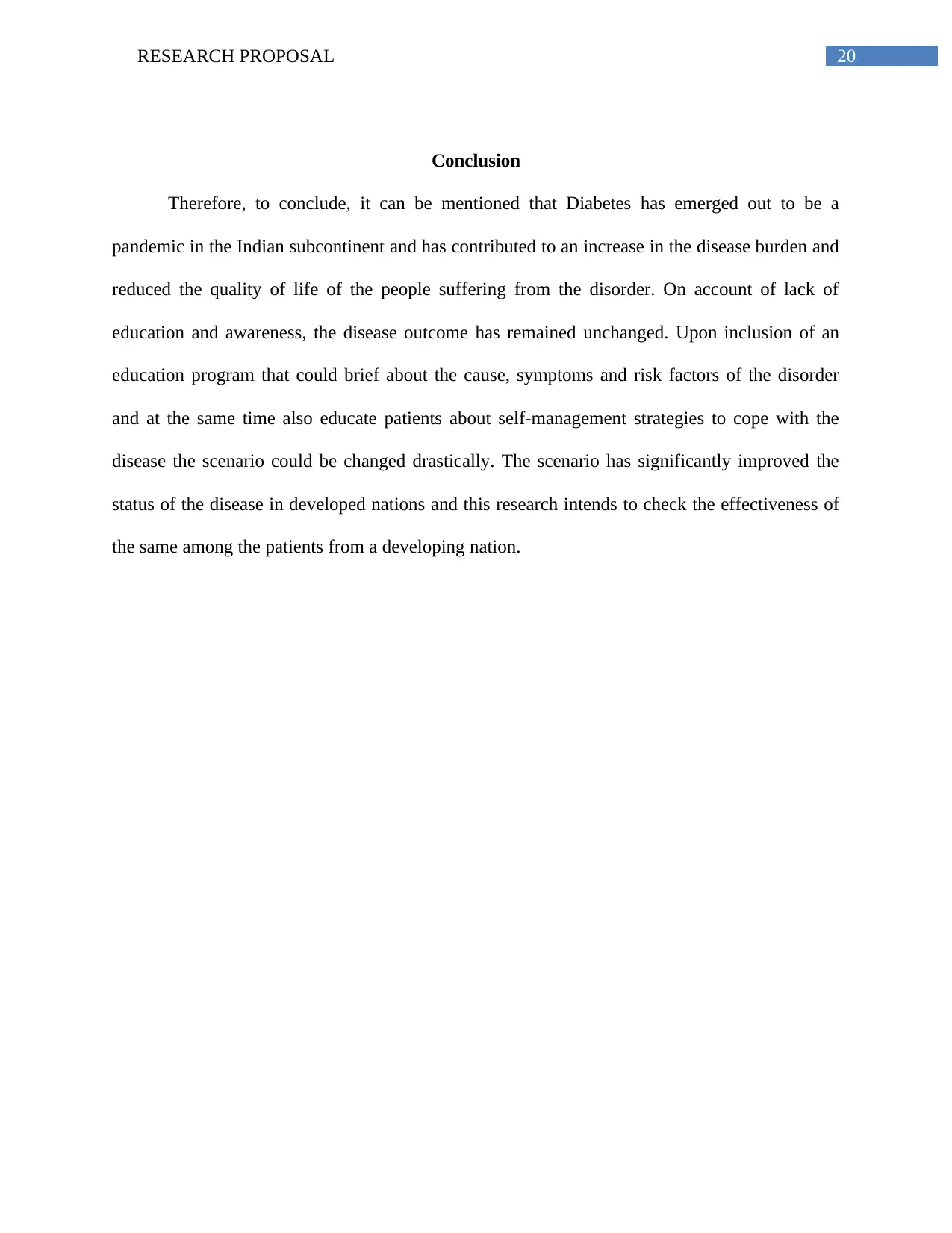
20RESEARCH PROPOSAL
Conclusion
Therefore, to conclude, it can be mentioned that Diabetes has emerged out to be a
pandemic in the Indian subcontinent and has contributed to an increase in the disease burden and
reduced the quality of life of the people suffering from the disorder. On account of lack of
education and awareness, the disease outcome has remained unchanged. Upon inclusion of an
education program that could brief about the cause, symptoms and risk factors of the disorder
and at the same time also educate patients about self-management strategies to cope with the
disease the scenario could be changed drastically. The scenario has significantly improved the
status of the disease in developed nations and this research intends to check the effectiveness of
the same among the patients from a developing nation.
Conclusion
Therefore, to conclude, it can be mentioned that Diabetes has emerged out to be a
pandemic in the Indian subcontinent and has contributed to an increase in the disease burden and
reduced the quality of life of the people suffering from the disorder. On account of lack of
education and awareness, the disease outcome has remained unchanged. Upon inclusion of an
education program that could brief about the cause, symptoms and risk factors of the disorder
and at the same time also educate patients about self-management strategies to cope with the
disease the scenario could be changed drastically. The scenario has significantly improved the
status of the disease in developed nations and this research intends to check the effectiveness of
the same among the patients from a developing nation.

21RESEARCH PROPOSAL
References:
Joshi, S.R., 2015. Diabetes care in India. Annals of Global health, 81(6), pp.830-838.
Powers, M.A., Bardsley, J., Cypress, M., Duker, P., Funnell, M.M., Fischl, A.H., Maryniuk,
M.D., Siminerio, L. and Vivian, E., 2017. Diabetes self-management education and support in
type 2 diabetes: a joint position statement of the American Diabetes Association, the American
Association of Diabetes Educators, and the Academy of Nutrition and Dietetics. The Diabetes
Educator, 43(1), pp.40-53.
Negarandeh, R., Mahmoodi, H., Noktehdan, H., Heshmat, R. and Shakibazadeh, E., 2013. Teach
back and pictorial image educational strategies on knowledge about diabetes and
medication/dietary adherence among low health literate patients with type 2 diabetes. Primary
care diabetes, 7(2), pp.111-118.
Hibbard, J.H. and Greene, J., 2013. What the evidence shows about patient activation: better
health outcomes and care experiences; fewer data on costs. Health affairs, 32(2), pp.207-214.
Bhojani, U., Mishra, A., Amruthavalli, S., Devadasan, N., Kolsteren, P., De Henauw, S. and
Criel, B., 2013. Constraints faced by urban poor in managing diabetes care: patients’
perspectives from South India. Global health action, 6(1), p.22258.
Kaveeshwar, S.A. and Cornwall, J., 2014. The current state of diabetes mellitus in India. The
Australasian medical journal, 7(1), p.45.
Shriraam, V., Rani, M.A., Sathiyasekaran, B.W.C. and Mahadevan, S., 2013. Awareness of
gestational diabetes mellitus among antenatal women in a primary health center in South
India. Indian journal of endocrinology and metabolism, 17(1), p.146.
References:
Joshi, S.R., 2015. Diabetes care in India. Annals of Global health, 81(6), pp.830-838.
Powers, M.A., Bardsley, J., Cypress, M., Duker, P., Funnell, M.M., Fischl, A.H., Maryniuk,
M.D., Siminerio, L. and Vivian, E., 2017. Diabetes self-management education and support in
type 2 diabetes: a joint position statement of the American Diabetes Association, the American
Association of Diabetes Educators, and the Academy of Nutrition and Dietetics. The Diabetes
Educator, 43(1), pp.40-53.
Negarandeh, R., Mahmoodi, H., Noktehdan, H., Heshmat, R. and Shakibazadeh, E., 2013. Teach
back and pictorial image educational strategies on knowledge about diabetes and
medication/dietary adherence among low health literate patients with type 2 diabetes. Primary
care diabetes, 7(2), pp.111-118.
Hibbard, J.H. and Greene, J., 2013. What the evidence shows about patient activation: better
health outcomes and care experiences; fewer data on costs. Health affairs, 32(2), pp.207-214.
Bhojani, U., Mishra, A., Amruthavalli, S., Devadasan, N., Kolsteren, P., De Henauw, S. and
Criel, B., 2013. Constraints faced by urban poor in managing diabetes care: patients’
perspectives from South India. Global health action, 6(1), p.22258.
Kaveeshwar, S.A. and Cornwall, J., 2014. The current state of diabetes mellitus in India. The
Australasian medical journal, 7(1), p.45.
Shriraam, V., Rani, M.A., Sathiyasekaran, B.W.C. and Mahadevan, S., 2013. Awareness of
gestational diabetes mellitus among antenatal women in a primary health center in South
India. Indian journal of endocrinology and metabolism, 17(1), p.146.
Paraphrase This Document
Need a fresh take? Get an instant paraphrase of this document with our AI Paraphraser
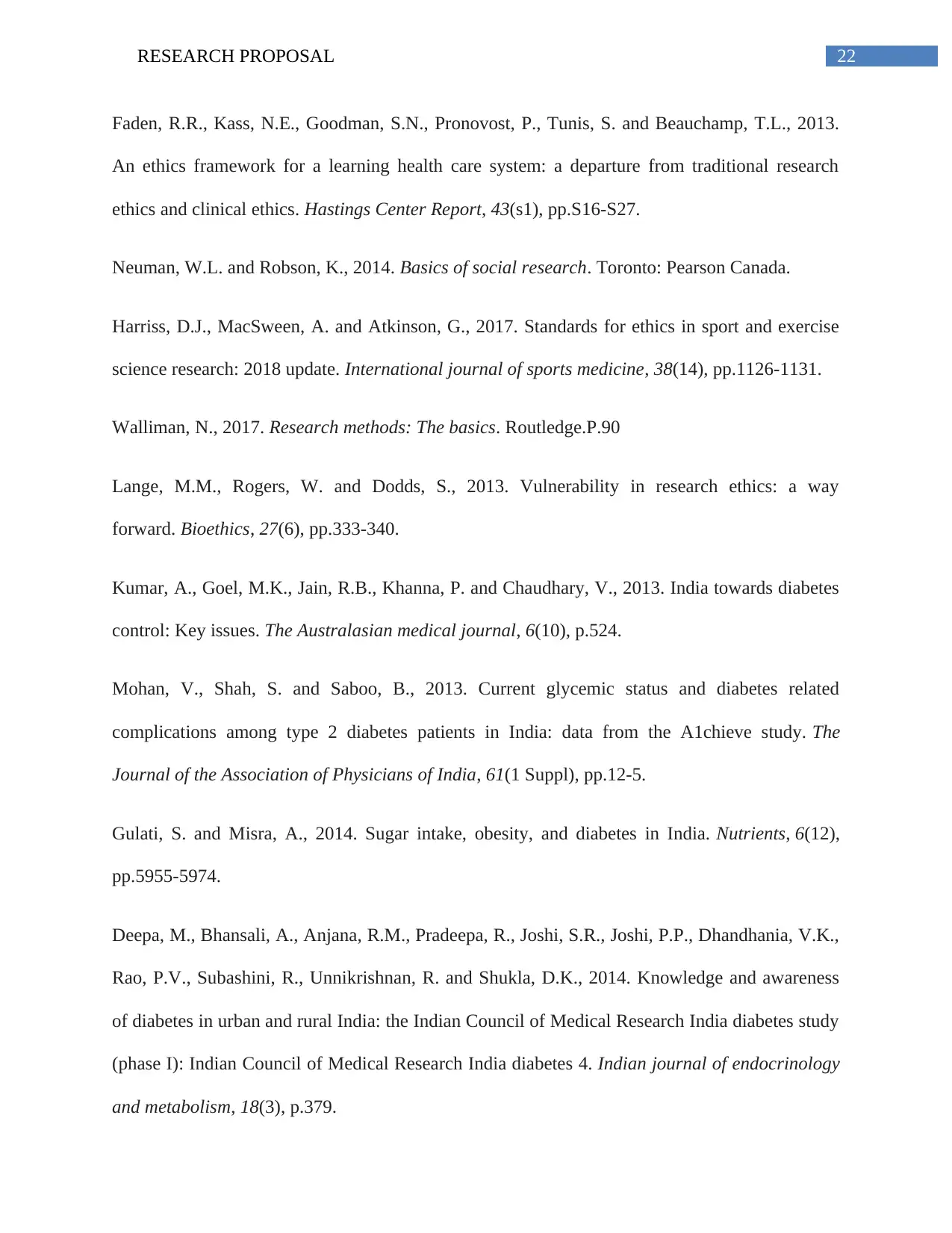
22RESEARCH PROPOSAL
Faden, R.R., Kass, N.E., Goodman, S.N., Pronovost, P., Tunis, S. and Beauchamp, T.L., 2013.
An ethics framework for a learning health care system: a departure from traditional research
ethics and clinical ethics. Hastings Center Report, 43(s1), pp.S16-S27.
Neuman, W.L. and Robson, K., 2014. Basics of social research. Toronto: Pearson Canada.
Harriss, D.J., MacSween, A. and Atkinson, G., 2017. Standards for ethics in sport and exercise
science research: 2018 update. International journal of sports medicine, 38(14), pp.1126-1131.
Walliman, N., 2017. Research methods: The basics. Routledge.P.90
Lange, M.M., Rogers, W. and Dodds, S., 2013. Vulnerability in research ethics: a way
forward. Bioethics, 27(6), pp.333-340.
Kumar, A., Goel, M.K., Jain, R.B., Khanna, P. and Chaudhary, V., 2013. India towards diabetes
control: Key issues. The Australasian medical journal, 6(10), p.524.
Mohan, V., Shah, S. and Saboo, B., 2013. Current glycemic status and diabetes related
complications among type 2 diabetes patients in India: data from the A1chieve study. The
Journal of the Association of Physicians of India, 61(1 Suppl), pp.12-5.
Gulati, S. and Misra, A., 2014. Sugar intake, obesity, and diabetes in India. Nutrients, 6(12),
pp.5955-5974.
Deepa, M., Bhansali, A., Anjana, R.M., Pradeepa, R., Joshi, S.R., Joshi, P.P., Dhandhania, V.K.,
Rao, P.V., Subashini, R., Unnikrishnan, R. and Shukla, D.K., 2014. Knowledge and awareness
of diabetes in urban and rural India: the Indian Council of Medical Research India diabetes study
(phase I): Indian Council of Medical Research India diabetes 4. Indian journal of endocrinology
and metabolism, 18(3), p.379.
Faden, R.R., Kass, N.E., Goodman, S.N., Pronovost, P., Tunis, S. and Beauchamp, T.L., 2013.
An ethics framework for a learning health care system: a departure from traditional research
ethics and clinical ethics. Hastings Center Report, 43(s1), pp.S16-S27.
Neuman, W.L. and Robson, K., 2014. Basics of social research. Toronto: Pearson Canada.
Harriss, D.J., MacSween, A. and Atkinson, G., 2017. Standards for ethics in sport and exercise
science research: 2018 update. International journal of sports medicine, 38(14), pp.1126-1131.
Walliman, N., 2017. Research methods: The basics. Routledge.P.90
Lange, M.M., Rogers, W. and Dodds, S., 2013. Vulnerability in research ethics: a way
forward. Bioethics, 27(6), pp.333-340.
Kumar, A., Goel, M.K., Jain, R.B., Khanna, P. and Chaudhary, V., 2013. India towards diabetes
control: Key issues. The Australasian medical journal, 6(10), p.524.
Mohan, V., Shah, S. and Saboo, B., 2013. Current glycemic status and diabetes related
complications among type 2 diabetes patients in India: data from the A1chieve study. The
Journal of the Association of Physicians of India, 61(1 Suppl), pp.12-5.
Gulati, S. and Misra, A., 2014. Sugar intake, obesity, and diabetes in India. Nutrients, 6(12),
pp.5955-5974.
Deepa, M., Bhansali, A., Anjana, R.M., Pradeepa, R., Joshi, S.R., Joshi, P.P., Dhandhania, V.K.,
Rao, P.V., Subashini, R., Unnikrishnan, R. and Shukla, D.K., 2014. Knowledge and awareness
of diabetes in urban and rural India: the Indian Council of Medical Research India diabetes study
(phase I): Indian Council of Medical Research India diabetes 4. Indian journal of endocrinology
and metabolism, 18(3), p.379.
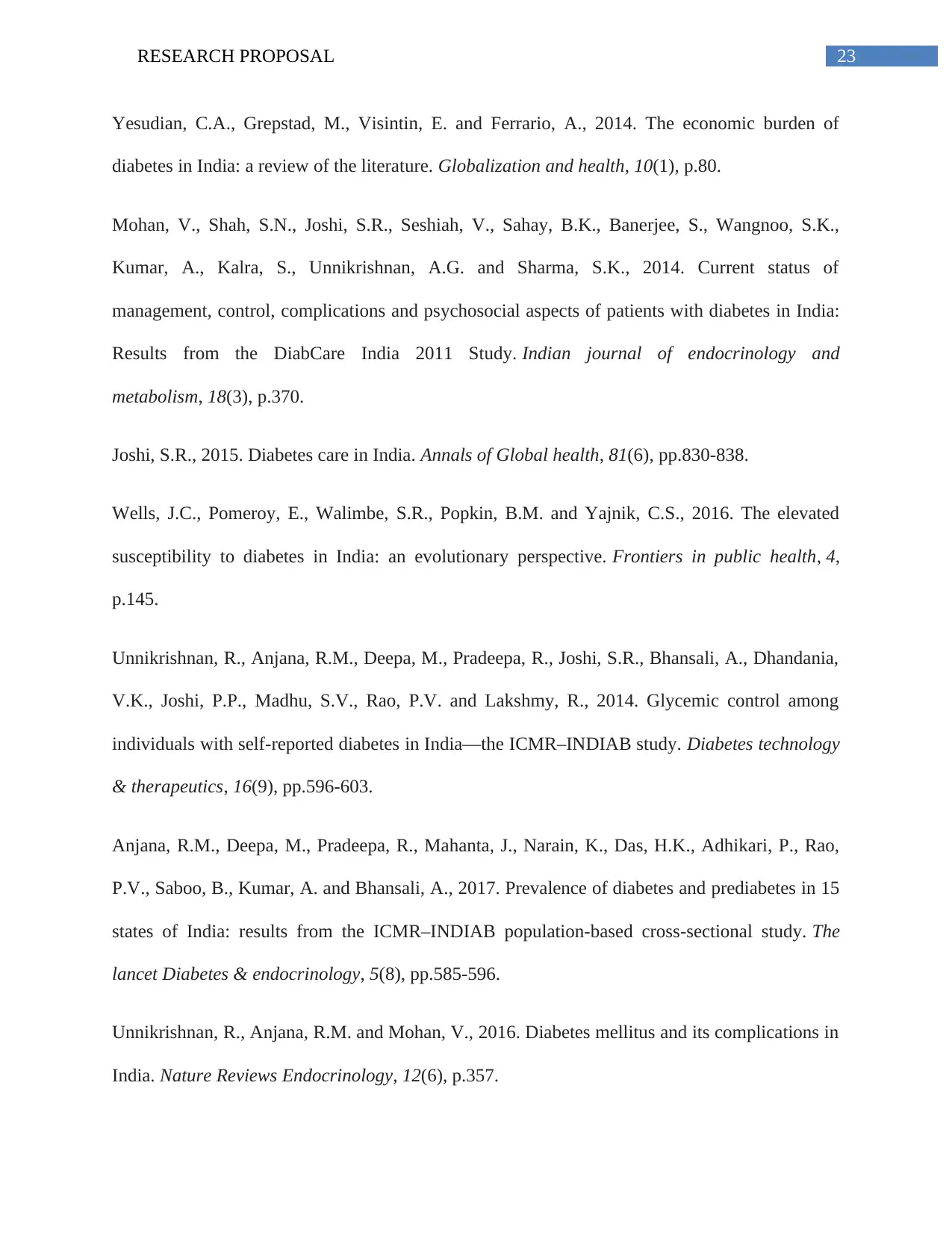
23RESEARCH PROPOSAL
Yesudian, C.A., Grepstad, M., Visintin, E. and Ferrario, A., 2014. The economic burden of
diabetes in India: a review of the literature. Globalization and health, 10(1), p.80.
Mohan, V., Shah, S.N., Joshi, S.R., Seshiah, V., Sahay, B.K., Banerjee, S., Wangnoo, S.K.,
Kumar, A., Kalra, S., Unnikrishnan, A.G. and Sharma, S.K., 2014. Current status of
management, control, complications and psychosocial aspects of patients with diabetes in India:
Results from the DiabCare India 2011 Study. Indian journal of endocrinology and
metabolism, 18(3), p.370.
Joshi, S.R., 2015. Diabetes care in India. Annals of Global health, 81(6), pp.830-838.
Wells, J.C., Pomeroy, E., Walimbe, S.R., Popkin, B.M. and Yajnik, C.S., 2016. The elevated
susceptibility to diabetes in India: an evolutionary perspective. Frontiers in public health, 4,
p.145.
Unnikrishnan, R., Anjana, R.M., Deepa, M., Pradeepa, R., Joshi, S.R., Bhansali, A., Dhandania,
V.K., Joshi, P.P., Madhu, S.V., Rao, P.V. and Lakshmy, R., 2014. Glycemic control among
individuals with self-reported diabetes in India—the ICMR–INDIAB study. Diabetes technology
& therapeutics, 16(9), pp.596-603.
Anjana, R.M., Deepa, M., Pradeepa, R., Mahanta, J., Narain, K., Das, H.K., Adhikari, P., Rao,
P.V., Saboo, B., Kumar, A. and Bhansali, A., 2017. Prevalence of diabetes and prediabetes in 15
states of India: results from the ICMR–INDIAB population-based cross-sectional study. The
lancet Diabetes & endocrinology, 5(8), pp.585-596.
Unnikrishnan, R., Anjana, R.M. and Mohan, V., 2016. Diabetes mellitus and its complications in
India. Nature Reviews Endocrinology, 12(6), p.357.
Yesudian, C.A., Grepstad, M., Visintin, E. and Ferrario, A., 2014. The economic burden of
diabetes in India: a review of the literature. Globalization and health, 10(1), p.80.
Mohan, V., Shah, S.N., Joshi, S.R., Seshiah, V., Sahay, B.K., Banerjee, S., Wangnoo, S.K.,
Kumar, A., Kalra, S., Unnikrishnan, A.G. and Sharma, S.K., 2014. Current status of
management, control, complications and psychosocial aspects of patients with diabetes in India:
Results from the DiabCare India 2011 Study. Indian journal of endocrinology and
metabolism, 18(3), p.370.
Joshi, S.R., 2015. Diabetes care in India. Annals of Global health, 81(6), pp.830-838.
Wells, J.C., Pomeroy, E., Walimbe, S.R., Popkin, B.M. and Yajnik, C.S., 2016. The elevated
susceptibility to diabetes in India: an evolutionary perspective. Frontiers in public health, 4,
p.145.
Unnikrishnan, R., Anjana, R.M., Deepa, M., Pradeepa, R., Joshi, S.R., Bhansali, A., Dhandania,
V.K., Joshi, P.P., Madhu, S.V., Rao, P.V. and Lakshmy, R., 2014. Glycemic control among
individuals with self-reported diabetes in India—the ICMR–INDIAB study. Diabetes technology
& therapeutics, 16(9), pp.596-603.
Anjana, R.M., Deepa, M., Pradeepa, R., Mahanta, J., Narain, K., Das, H.K., Adhikari, P., Rao,
P.V., Saboo, B., Kumar, A. and Bhansali, A., 2017. Prevalence of diabetes and prediabetes in 15
states of India: results from the ICMR–INDIAB population-based cross-sectional study. The
lancet Diabetes & endocrinology, 5(8), pp.585-596.
Unnikrishnan, R., Anjana, R.M. and Mohan, V., 2016. Diabetes mellitus and its complications in
India. Nature Reviews Endocrinology, 12(6), p.357.
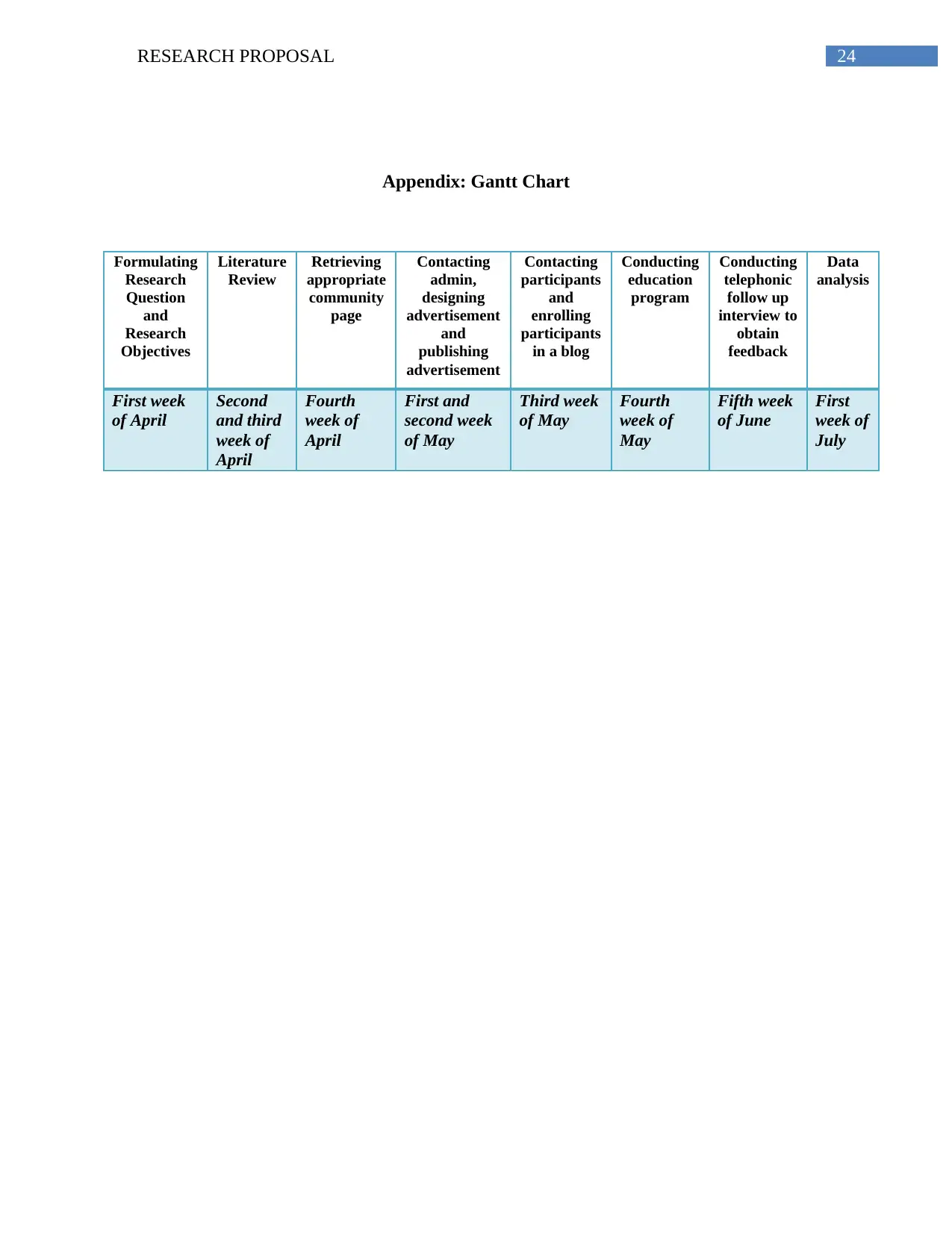
24RESEARCH PROPOSAL
Appendix: Gantt Chart
Formulating
Research
Question
and
Research
Objectives
Literature
Review
Retrieving
appropriate
community
page
Contacting
admin,
designing
advertisement
and
publishing
advertisement
Contacting
participants
and
enrolling
participants
in a blog
Conducting
education
program
Conducting
telephonic
follow up
interview to
obtain
feedback
Data
analysis
First week
of April
Second
and third
week of
April
Fourth
week of
April
First and
second week
of May
Third week
of May
Fourth
week of
May
Fifth week
of June
First
week of
July
Appendix: Gantt Chart
Formulating
Research
Question
and
Research
Objectives
Literature
Review
Retrieving
appropriate
community
page
Contacting
admin,
designing
advertisement
and
publishing
advertisement
Contacting
participants
and
enrolling
participants
in a blog
Conducting
education
program
Conducting
telephonic
follow up
interview to
obtain
feedback
Data
analysis
First week
of April
Second
and third
week of
April
Fourth
week of
April
First and
second week
of May
Third week
of May
Fourth
week of
May
Fifth week
of June
First
week of
July
1 out of 25
![[object Object]](/_next/static/media/star-bottom.7253800d.svg)





